Two—
Indecision and Change
Berlin, Winter 1887–88
In the spring of 1887 when Corinth left Paris, he had completed more than a decade of academic study. He might have looked back on this period with a greater sense of accomplishment had he been able to add to his bronze medal for The Conspiracy a similar token of recognition for his years at Julian's. As it was, he returned to East Prussia with little more to show than a few studies of the nude model. The knowledge that he was approaching his thirtieth birthday must have weighed heavily on him. Fortunately, he did not suspect that thirteen years of search and experimentation still lay ahead.
Except for a brief visit to the Baltic seacoast, Corinth spent the summer of 1887 in Königsberg. Of the five paintings he completed at this time the portrait of his father (Fig. 20) is the most important. In it once again he depicted a figure in a sunlit interior, except that, as in the portrait of 1883 (see Plate 1), Franz Heinrich does not really occupy that interior but sits in front of it. Daylight, entering through the window at the right, fills the room with a subtle glow, accentuates the structure of the sitter's face, and touches details with a sparkle of bright color. The pale blue of the letter Franz Heinrich holds in his right hand echoes the white and blue of the curtains and the windowpane. Patches of red and yellow enliven the dull green of the tablecloth. Although this portrait was painted only four years after the Munich portrait, Franz Heinrich looks not only markedly older but also much more frail. As in the earlier portrait, the posture is casual, but it fails to convey the same impression of comfort and ease. Instead, Corinth's father is seated rather stiffly in the armchair and seems unable to support his weight without effort. The face is taut, the expression of the eyes weary. Corinth must have begun the portrait shortly after his return from Paris, for at the end of July the painting was included in an exhibition organized by the Berlin Artists' Association at the Glass Palace in Berlin. It was moderately successful at best. According to Corinth, some of the critics "thoroughly flogged" him.[1]
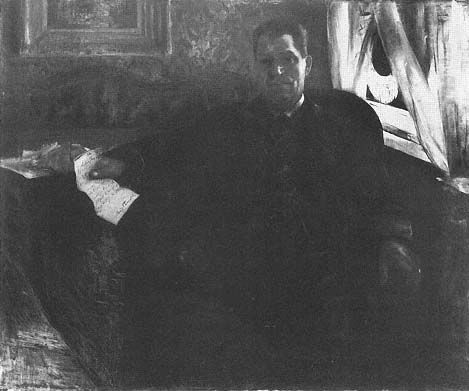
Figure 20
Lovis Corinth, Portrait of Franz Heinrich Corinth with a Letter , 1887.
Oil on canvas, 87 × 105 cm, B.-C. 51. Museum Ostdeutsche Galerie Regensburg.
Photo: WS-Meisterphoto Wolfram Schmidt.
Despite this inauspicious reception, in October Corinth went to Berlin to pursue opportunities that by his own account were luring artists to the city:
Berlin was thriving at the time. The population was expanding, and a strong interest in art was just beginning to develop. One could find plenty of newly rich bankers who were willing to support the arts, and it was easy for ambitious, capable, and truly talented painters to establish art schools of their own. This was the reason many young artists moved from Munich to Berlin, and if one was lucky enough to be a foreigner, one's fortune was already made.[2]
By the time Corinth arrived, Berlin had already experienced more than a decade of astonishing growth. After 1871 this old seat of the Hohenzollerns, suddenly the capital of a unified German Empire, was transformed into a major metropolis. With the city's intensified economic development, commerce and industry grew at a dizzying rate. As corporations and banks multiplied, immense private fortunes were created. Newcomers arrived by the thousands. In only nine years—from 1864 to 1875—the city's population almost doubled, passing the one-million mark. By 1885 it had increased to nearly a million and a half.[3] In 1872 alone no fewer than forty new construction firms began to operate,[4] gradually pushing the city's perimeter further west; mansions near the Tiergarten soon vied in opulence with the splendid apartment buildings along the Kurfürstendamm.
The visual arts in Berlin were dominated during these years by the Berlin Academy and its influential director Anton von Werner. Werner, still remembered for his photographically accurate depictions of scenes from the Franco-Prussian War, was only thirty-two when he became director of the academy in 1875. From 1887 to 1895 he also served as president of the Berlin Artists' Association, whose members controlled the annual academy-sponsored exhibitions. Until 1885 these exhibitions were predominantly local; not until the academy's centennial anniversary exhibition in 1886 were artists from other German cities and from abroad encouraged to participate in larger numbers. The 1886 exhibition, intended to propel Berlin into the intellectual and artistic community of older, more illustrious European capitals, turned out to be the nation's cultural event of the year and a matter of great national pride. Die Kunst für Alle , Germany's leading art journal at the time, devoted ten consecutive biweekly issues to the exhibition.[5] In addition to the German contingent, artists from nine foreign countries exhibited in the newly built Glass Palace—England, Belgium, Holland, the Scandinavian countries, Italy, Spain, and Russia. France—not unexpectedly—chose not to participate.
While the leading academicians reaped their customary accolades and medals from the exhibition, younger, innovative artists did not go unnoticed. Among the Germans was Max Liebermann, who exhibited three paintings: The Old Men's Home in Amsterdam (1880–1881; Collection Georg Schäfer, Schweinfurt), Girls from the Amsterdam Orphanage in a Garden (1885; Kunsthalle, Hamburg), and Saying Grace (1886; private collection). The first two paintings were generally well received. The third elicited mixed reactions. Most critics applauded the sincerity of the religious sentiment portrayed but found Liebermann's unidealized models and their humble milieu offensive.
The same criticism was directed at two religious paintings submitted by Fritz von Uhde, Come, Lord Jesus, Be Our Guest (1885; Staatliche Museen zu Berlin, National-Galerie), and The Last Supper (1886; present location unknown). But since these paintings made up in anecdotal interest whatever the figures lacked in conventional "beauty of form," Uhde received on the whole a more generous recognition than Liebermann.[6]
The academy exhibition of the following year, to which Corinth sent the recently completed portrait of his father, included few foreign artists. Moreover, most of the established German academicians, apparently not yet recovered from the previous year's exhibition, refrained from showing. A reviewer noted instead a marked increase in the number of younger German artists preoccupied with the same pictorial problem: plein air.[7] Liebermann was represented with his paintings Beer Garden in Munich (1884; Bayerische Staatsgemäldesammlungen, Neue Pinakothek, Munich) and Women Spinning (1880; painting lost) and Uhde with his first biblical scene in an outdoor setting, The Sermon on the Mount (1884; Museum of Fine Arts, Budapest). The exhibition's succès de scandale belonged to Max Klinger, whose monumental painting The Judgment of Paris (1886–1887; Kunsthistorisches Museum, Vienna) elicited a wave of hostile criticism. Klinger's uncompromising naturalism in depicting the three nude goddesses led the Kreuzzeitung to publish a stern editorial on the decay of morals. Critics derided as the ultimate proof of his folly his efforts to fuse the picture and its immediate environment into a Gesamtkunstwerk by setting the huge canvas into an elaborate polychrome sculptured frame.[8]
The battle for modern art in Berlin was waged less vociferously in the galleries of two private dealers, Eduard Schulte and Fritz Gurlitt. Schulte, who in 1885 had taken over the former Salon Lepke on Unter den Linden, generally followed the accepted academic trend, though he did not exclude controversial artists altogether. In the winter of 1887–88, besides a number of portraits by Lenbach, he exhibited a group of paintings by Arnold Böcklin, an artist who had only begun to receive some recognition. Gurlitt was more enterprising. Since opening his gallery in 1880, he had displayed the work of painters from throughout Germany. He was among the first to exhibit works by Hans von Marées and Hans Thoma. His gallery was also the only place in Berlin where paintings by the French Impressionists could be seen. In October 1883 Gurlitt exhibited the small but exquisite collection assembled by Carl and Felicie Bernstein, consisting of works by Manet, Monet, Sisley, Pissarro, Gonzalez, and Morisot. Shortly thereafter he showed a selection of
works by Pissarro, Renoir, and Degas sponsored by the Parisian art dealer Paul Durand-Ruel. Gurlitt's exhibitions inspired the young French Symbolist poet and critic Jules Laforgue, who from 1881 to 1886 lived primarily in Berlin, serving as a reader to the German empress Augusta, to write one of the earliest and most incisive analyses of Impressionism.[9]
The artistic milieu Corinth encountered when he arrived in Berlin in October 1887 thus offered the old and established as well as the new. It is not known whether he had visited the Berlin Academy exhibition at the Glass Palace during the summer, but because the portrait of his father was shown there, he was probably aware of the growing reputation of such artists as Liebermann, Uhde, and Klinger. Corinth himself, however, was not one to eagerly follow the avant-garde. His continuing image of himself as a student is suggested by his later confession that he felt "intimidated" on arriving in Berlin; aside from a "pent-up ambition to learn something," he had neither the "courage nor the determination to take any adventurous risks."[10]
Indeed, Corinth's Berlin output, dominated by drawings of male and female nudes, is little more than a continuation of his student work from Paris. Most of these drawings originated at Der Nasse Lappen (The Wet Rag), a private drawing club he joined soon after his arrival. Der Nasse Lappen was founded by Carl Steffeck, who had taught at the Berlin Academy from 1859 until his departure for the academy in Königsberg in 1880. Members of the club met in the evenings to draw after the live model. In the late 1880s the artists who took part in this Abendakt , in a studio on Potsdamer Strasse, included the painters Carl Friedrich Koch, Paul Souchay, and Adolf Schlabitz and the sculptor Max Klein. The art historian Heinrich Weizsäcker also occasionally joined the drawing sessions.[11] Corinth soon got to know the most prominent member of the group, Karl Stauffer-Bern, well enough to visit him in his studio on Klopstockstrasse, and the Swiss artist apparently introduced him at this time to Max Klinger and to the Berlin painter Walter Leistikow.
Although Karl Stauffer (1857–1891), a native of Bern, was only a year older than Corinth, he had already made a name for himself as a portraitist among the newly rich of Berlin. He also enjoyed the special favor and protection of Anton von Werner, who had helped him to secure his first important portrait commissions, which in due course included the portrait of the emperor's surgeon, Dr. von Lauer, and a portrait of the emperor himself. Adolph von Menzel, whose portrait Stauffer-Bern etched in 1885, was so impressed with the young man's talent that he frequently invited him to his home for dinner, an honor he bestowed on only a few. It was the "foreigner" Karl Stauffer-Bern
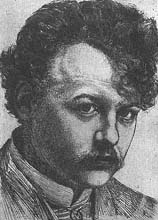
Figure 21
Karl Stauffer-Bern,
Self-Portrait , c. 1885.
Etching, 35 × 22 cm.
Kunstmuseum Bern (S 10692).
whom Corinth clearly had in mind when he wrote of those "ambitious, capable, and truly talented painters" who had succeeded in launching profitable teaching careers in the nation's new capital. For in addition to pursuing his creative work, Stauffer-Bern both directed the portrait class of the Berlin Society of Women Artists and Friends of the Arts, whose students in 1885 included Käthe Kollwitz, then eighteen years old, and maintained a small ladies' academy of his own.[12]
Stauffer-Bern must have embodied for Corinth the success he himself was striving for. He had reason to believe the goal within his reach, moreover, for Stauffer-Bern's work was based on formal principles that Corinth was in the process of making his own. Both artists had been trained by Löfftz at the academy in Munich. Stauffer-Bern's reputation today rests primarily on his prints, although he made no more than thirty-seven.[13] His portrait etchings, such as the Self-Portrait (Fig. 21) of about 1885, convey the sitter's presence with striking immediacy, a quality he considered indispensable: "In my portraits I am not concerned with snappy execution or coloristic appeal but rather with the mathematically precise reproduction of form and the most delicate modeling, . . . because a portrait must be above all so lifelike that one is startled by it."[14]
When drawing the nude model, which he considered the "painter's alphabet" and "the foundation of all art," Stauffer-Bern was guided by the same desire "to reproduce the exquisite details of nature, to penetrate the secrets of appearances, and to become a master of what he could see."[15] As a result, his drawings primarily document visual facts, although the sculptural plasticity of his figures also has expressive power (Fig. 22). Weizsäcker considered
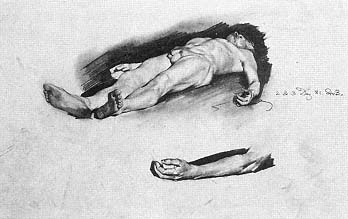
Figure 22
Karl Stauffer-Bern, Recumbent Male Nude ,
1881. Pencil, 25.0 × 39.5 cm.
Kunstmuseum Bern (A 3461).
Stauffer-Bern's drawings among the best anywhere: "What a joy it was to leaf through the portfolios and sketchbooks in his studio at one's leisure! How . . . the most delicate vibration of form was observed, with what intelligence and at the same time with what energy, often after several new beginnings, until the image had been seized."[16]
Since he was not satisfied with the soft gradations obtainable with the etching needle alone, Stauffer-Bern frequently reworked his plates with the burin to achieve more emphatic contrasts in value. Emulating the Italian engravers of the fifteenth century, he applied the burin so that the hatchings do not follow the round forms of the human body but create shadows with a network of straight, precisely drawn parallel lines.
In addition to portraits and nudes, Stauffer-Bern favored religious compositions. A painting representing Christ in the house of Simon the Pharisee was to have been one of his major works. Begun in 1884 on a large scale—the canvas measured approximately eight by sixteen feet and was projected to contain seventeen life-size figures—it was never completed. From 1886 to 1887 he worked on a dead Christ motif inspired by Holbein's picture in Basel, and during the winter of 1887 he painted the Crucified Christ (Fig. 23), an impeccable anatomical depiction of the model, whose brightly illuminated body is set off against a dark ground. Sixteen years later Corinth wrote that this painting was like an "oasis in the desert" for him during that winter, and although by the time he made the statement he had begun to reject Stauffer-Bern's conception as too literal, he professed continued respect for the Swiss artist as a "master of form," emphasizing that the nude human figure could be considered (as he paraphrased Stauffer-Bern himself) the "Latin of painting."[17]
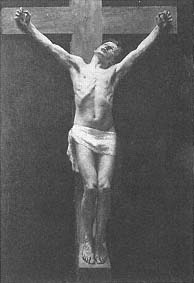
Figure 23
Karl Stauffer-Bern, Crucified Christ ,
1887. Oil on canvas, 247 × 168 cm.
Kunstmuseum Bern.
Corinth's contact with Stauffer-Bern, however, was short-lived. Stauffer-Bern tended to be impulsive; he loved to theorize, but without reflecting. According to his biographer Georg Wolf, "Clichés flowed effortlessly into his speech. He preached about art and artistry, demonstrated mature judgment alongside sky-high naïveté, and developed plans on a grand scale for an entire generation of Raphaels and Buonarrotis."[18] Similarly high-flown ideas apparently ended Stauffer-Bern's friendship with Corinth. When on Christmas Eve 1887 he tried to explain to Corinth over a bottle of wine his concept of a Gesamtkunstwerk that—like Klinger's—was to unite painting and sculpture, Corinth bluntly countered by quoting a well-known vulgar line from Goethe's Götz von Berlichingen and left.[19] The two men never saw each other again. In the spring of 1888 Stauffer-Bern left for Rome to devote himself entirely to the practice of sculpture. His unfortunate love affair with Lydia Welti-Escher, the wife of his influential Swiss patron, led in quick succession to his imprisonment and commitment to mental institutions in Rome and Florence and to his suicide at the age of thirty-three on January 24, 1891. Yet despite the brevity of their relationship, Stauffer-Bern had a decisive effect on Corinth's development and continued to influence him for several years. His example encouraged Corinth's own desire to become a "master of form," and the Crucified Christ remained proof that this mastery could be put effectively to the service of a major theme.
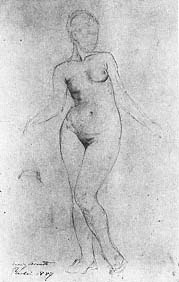
Figure 24
Lovis Corinth, Standing Female
Nude , 1887. Pencil, 52.8 × 34.5 cm.
Staatliche Museen, Berlin (DDR).

Figure 25
Lovis Corinth, Standing Female
Nude , 1887–1888. Pencil,
44.7 × 29.5 cm.
Kunsthalle Bremen.
Corinth's Berlin drawings in particular indicate the extent to which he emulated Stauffer-Bern's concept of form. Although relatively few examples have survived, he apparently worked extensively at drawing during the winter of 1887–88. A mise en place sketch (Fig. 24) in the idealizing French manner was probably done soon after Corinth arrived in Berlin. Sweeping reinforced contours define the stereometrically simplified body while a gently swaying line of action proceeds from the model's neck through the navel and pubic area to the inner contour of the left leg. Like Bouguereau's Venus (see Fig. 14), the figure is eight heads high, with the upper and lower portions of the body containing four heads each. By comparison, several drawings in a sketchbook now in the Kunsthalle in Bremen illustrate how Corinth adopted Stauffer-Bern's emphasis on plasticity of form and painstaking verisimilitude. The drawing of a standing female nude (Fig. 25) on folio 3 recto, for example, is superior to any of Corinth's earlier life drawings in accuracy of rendering. The modeling, contained by smooth contour lines, recalls the parallel hatchings in Stauffer-Bern's prints and makes the supple flesh palpable. The woman, directly observed, conveys the sense of a real, living presence. In several drawings in the Bremen sketchbook the anatomical depiction of the model is complemented by careful studies of detail; in others the sculptural clarity of the figure is enhanced by conspicuous shadows, as in similar drawings by Stauffer-Bern.
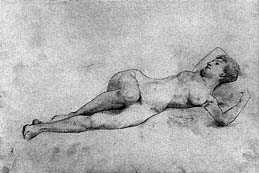
Figure 26
Lovis Corinth, Reclining Female Nude ,
1887–1888. Pencil, 29.5 × 44.7 cm.
Kunsthalle Bremen.
Although most of the drawings in the Bremen sketchbook display the same remarkable naturalism, Corinth did not abandon the idealizing tendencies of his French teacher entirely. On the contrary, as his command of life drawing grew, he could not only express the visual data manifested in the model but also achieve a more sophisticated grasp of conceptualized form. His drawing of a reclining female nude (Fig. 26) on folio 28 recto follows the practice of Bouguereau by combining the realistic head of a modern woman with a graceful, idealized body. A transparent chiaroscuro accentuates the soft forms of the model, and delicate flowing contours emphasize the body's sensuousness.
Corinth's works during the Berlin winter culminated in at least two paintings, each depicting a female nude. The smaller of the two (B.-C. 54), dated 1888, is based on a drawing in the Kunsthalle in Hamburg;[20] the other (Fig. 27) bears the date 1887 and was clearly preceded by drawings like the one shown in Figure 26. The 1887 painting is the more finished and more ambitious of the two. The model is shown life-size, reclining on a bed of silky cushions and sheets, her back turned seductively toward the viewer. Both paintings further elaborate Corinth's drawings from life; both are exercises, efforts to endow visual perception with concrete pictorial form. The meticulous and richly nuanced modeling of the flesh parts suggests that these works are those of which Corinth, remembering Bouguereau's criticism of his draftsmanship, later wrote: "I seriously tried to capture the forms by working from the live model; in my pictures there was not to be a speck that was not rigorously studied."[21]
The same disciplined brushwork is seen in the Self-Portrait (Fig. 28) from the winter of 1887–88. Like Stauffer-Bern's portrait etchings, the painting projects the artist's physical presence with "startling" immediacy. Although this
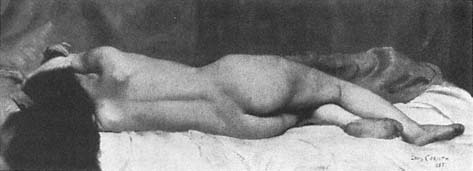
Figure 27
Lovis Corinth, Reclining Female Nude , 1887. Oil on canvas, 65 × 175 cm,
B.-C. 53. Present whereabouts unknown.
Photo: after Bruckmann.
effect results partly from the quizzical, apprehensive gaze, it is reinforced by the tangible life-size head emerging from the undifferentiated pictorial ground. The meticulous modeling is in keeping with Stauffer-Bern's precept that "mathematically precise reproduction of form" is the basis of other, more expressive, qualities in a given portrait. Indeed, more than twenty years later Corinth, commenting on the art of portraiture, restated the precept in his own teaching manual with remarkable accuracy:
A specific individual has here been portrayed, and the first requirement is verisimilitude. Perhaps some will say that in a work of art other qualities could be considered more important, since in most cases only a very few will know the sitter by face. However, such other affective qualities as immediacy of expression and liveliness of conception are only the inevitable result of verisimilitude.[22]
Corinth's awareness of his increasing technical proficiency during the winter of 1887–88 is reflected, at least indirectly, in his decision that his name henceforth should be Lovis. For some time he had been signing his works in capital letters, replacing the U in his first name with the less conventional roman V . He now began using the v for the lower case spelling of his name as well, adopting Lovis as his professional name; legally, however, his name remained unchanged.
In February 1888 Lovis Corinth participated again in an exhibition organized by the Berlin Artists' Association. Two of the paintings he showed, the portrait of a young architect named Tietz, painted the year before, and a picture entitled Hospital Women at Their Morning Prayer , were either destroyed by Corinth or overpainted, and nothing is known about them except what can be
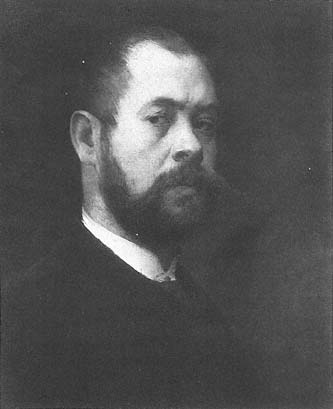
Figure 28
Lovis Corinth, Self-Portrait , 1887–1888. Oil on canvas,
53.5 × 43.0 cm, B.-C. 49.
Sammlung Georg Schäfer, Schweinfurt.
gleaned from a reviewer's brief remarks critical of the forced facial expressions in both works. The third painting was Corinth's seasoned prizewinner The Conspiracy , which once again drew favorable comments.[23]
Corinth's further efforts to establish himself in Berlin were cut short when his father called him home at Easter time. As the portrait from the previous summer suggests, Franz Heinrich was ailing, and the wish to have his son near him was most likely prompted by a further deterioration of his health.
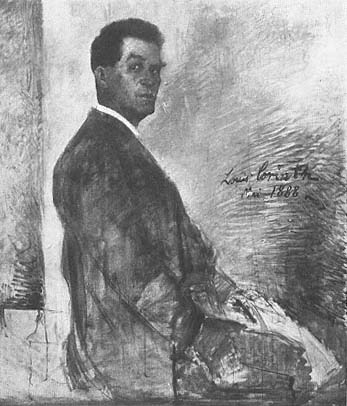
Figure 29
Lovis Corinth, Portrait of Franz Heinrich Corinth , 1888.
Oil on canvas, 118 × 100 cm, B.-C. 56.
Private collection.
Königsberg, 1888–1891
The portrait Corinth painted of his father when he returned home in May 1888, however, gives no indication of Franz Heinrich's illness (Fig. 29). On the contrary, the upright posture and alert gaze convey undiminished physical and mental vigor. The sitter is seen from up close and slightly below, his head turned, almost abruptly, toward the viewer. The raised eyebrows and firm mouth give the face a look of quiet resolve. The resulting effect of controlled tension differs considerably from the calm mood of Corinth's earlier portraits
of his father. Psychic energy emanates from the unfinished work, in which only the face has been given definition—again in emulation of Stauffer-Bern's "mathematically precise" rendering of form. The rest of the portrait is barely sketched out, reinforcing the head as the principal carrier of the picture's expressive content. Corinth apparently began the painting as a more developed statement of the formula he had first adopted in the Berlin self-portrait, and he prepared the picture with special care, as several preliminary drawings show. He may have left the painting unfinished because he could not maintain so energetic a conception in the face of his father's true state of health; perhaps the sittings had to be suspended. In any event, the portrait remains more a wishful projection than a record of fact. Corinth's desire to remember Franz Heinrich as he looked in this portrait—psychologically the most interesting one he painted of his father—is evident from his fondness for it. He kept it with him throughout his life and always had it hung opposite his favorite armchair. "I want to look at the old man," he told his wife many years later; "I think of him each day."[24]
Franz Heinrich's vigorous appearance in the portrait was indeed deceptive. When Corinth returned to Königsberg at the end of September from a month of military reserve duty in the nearby town of Pillau, he found his father severely ill and confined to bed. This is how he painted him in October (see Plate 3). The small, intimate canvas is the best of Corinth's early sunlit interiors—a masterpiece that shows him in complete command of his painterly means. The composition recalls Jozef Israëls's The Widower , which had inspired Corinth's "fledgling work" The Conspiracy . Corinth's sense that the subject fit the anecdotal conventions of late nineteenth-century genre painting is indicated by his own original title for the work, The Sick Man .[25] Unlike Israëls, however, Corinth avoided sentimentality by sublimating his empathy in a loving description of the room and its two inhabitants. Franz Heinrich seems to sleep while the young woman briefly stops knitting to gaze at him. The autumn sunlight gleams on the furniture and on the still life of medicine bottles, glasses, and fresh flowers beside the bed. The small carnation withering on the chair is a poignant reminder of the picture's content. Objectivity and simplicity of conception make this painting the most heartfelt of Corinth's early works. With it he also bade his father a tender farewell: Franz Heinrich died on January 10, 1889, a month before his sixtieth birthday.
Corinth inherited three apartment houses his father had bought in Königsberg in the 1870s as well as other substantial investments. He was now financially secure and independent, a fortunate situation indeed, for so far he had found no buyers for his pictures. He was now free to pursue his career virtu-
ally anywhere. Although he had visited Königsberg only intermittently during the preceding nine years—always to see his father—he decided to stay. His decision most likely had to do with his inexperience in administering and supervising his property, and he no doubt thought it wise not to stray too far—for the time being—from the sources of his income.
Soon after his father's death Corinth rented a studio at Rossgärter Passage 1 and resumed contact with some of his former teachers and fellow students from the Königsberg Academy. He also joined the Königsberg Artists' Association and in March 1889 exhibited with the organization for the first time. In addition to a kitchen still life (B.-C. 68), painted over the ill-fated earlier picture from Antwerp, he showed The Conspiracy once again, although many Königsbergers had already seen the painting on display in the window of the gallery of Bruno Guttzeit, a local dealer. A reviewer of the exhibition noted this with disappointment and chided Corinth for not submitting any of his more recent works from Paris, some of which had also been exhibited at Guttzeit's.[26] Among the "Parisian" works alluded to were most likely Corinth's Berlin nudes. His decision not to show them in the competitive context of the Königsberg Artists' Association exhibition, which included pictures by Lenbach, Böcklin, and Uhde, suggests that he recognized the tentative character of these works.
From 1889 to 1891 Corinth assimilated his most recent experiences in Paris and Berlin, further developing ideas he had not yet been able to realize fully. For example, in the portrait of Carl Bublitz (Fig. 30) he built on the conception he had first explored in the Berlin self-portrait and in the May 1888 portrait of his father (see Fig. 29). Now, however, he intensified the impression of immediacy by relating the sitter to the viewer through gesture as well as glance. Carl Bublitz (1866–1932), who had also studied at the Königsberg Academy, is depicted half-length in Corinth's studio; he stands next to an empty canvas, echoing its diagonal position in his own animated posture. In the background is a portion of Corinth's only known plein air picture from this period, Swimming Pond near Grothe, Königsberg (B.-C. 72), also painted in 1890. Bold contrasts of light and shade, induced by the bright illumination from the left, play a major part in the compositional structure of the Bublitz portrait. And the broad, energetic application of the paint itself suggests palpitating life.
The technique employed in the portrait of Hugo Rogall (Fig. 31), an actor at the Königsberg municipal theater who belonged to Corinth's circle of friends, is more controlled, although here, too, vigorous brushstrokes enliven subordinate areas of the canvas. The conception is as lively as that of the Bublitz portrait, but this sitter's expression and posture are more pointedly provoca-
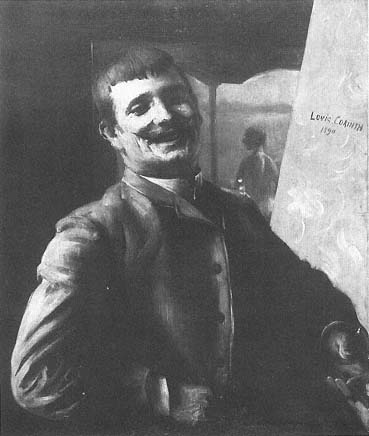
Figure 30
Lovis Corinth, Portrait of the Painter Carl Bublitz , 1890.
Oil on canvas, 90 × 74 cm, B.-C. 70.
Sammlung Georg Schäfer, Schweinfurt.
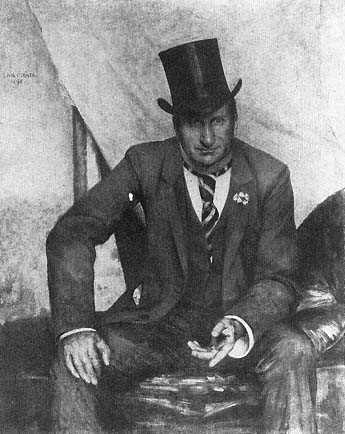
Figure 31
Lovis Corinth, Portrait of the Actor Hugo Rogall , 1890.
Oil on canvas, 75 × 50 cm, B.-C. 71. Only a fragment of this
painting survives; present whereabouts unknown.
Photo: after Bruckmann.
tive. The shallow space and simple background help to focus attention on Rogall, whose nonchalance is reinforced by his open jacket and unbuttoned vest. The top hat, set slightly askew, and the jaunty flower in the lapel add affable touches to the otherwise robust, even aggressive, characterization. Unfortunately, Corinth later cut the painting apart, keeping only the fragment with Rogall's head.
Both of these portraits bring to mind Frans Hals, who used posture and gesture to establish a dialogue between his sitters and the viewer. Corinth most likely drew consciously on the Dutch master in his efforts to heighten the illusion of a momentary encounter in which an individual's character reveals itself in emotion and movement. Although he was to explore such baroque elements more fully later, these two portraits mark the first stage in the development of a flamboyant conception now recognized as a characteristic of Corinth's mature style.
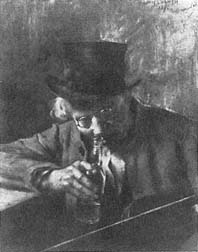
Figure 32
Lovis Corinth, The Old Drinker , 1889.
Oil; ground and size unknown, B.-C. 67.
Present whereabouts unknown.
Photo: after Bruckmann.
The Old Drinker (Fig. 32) of 1889 apparently also has Dutch prototypes. Holding a violin under his left arm, the smiling old man sniffs at a bottle. His contented look evokes the pleasures of both music and drink. Half-length figures of musicians and drinkers, usually shown against a neutral ground, were an invention of the Utrecht Caravaggisti but were also painted frequently by Frans Hals. Opinion differs on what these paintings represent: subjects from daily life or allegories on the popular theme of the Five Senses. In Corinth's painting the allegorical reference to hearing, smell, and taste is clear in the juxtaposition of violin and bottle. In seventeenth-century Dutch paintings of the type the figures usually wear theatrical costumes that suggest their allegorical roles. Corinth updated this tradition by placing his merry toper in a contemporary bohemian context.
Although The Old Drinker and the portraits of Bublitz and Rogall derive much of their interest from Corinth's empathy with his subject, his figure compositions from these years indicate his continuing preoccupation with pictorial problems he had tried to solve in Munich and Paris. A motif from Paris, "a corpse of Christ on a red tile floor," awkwardly drawn in the Kiel sketchbook (see Fig. 18), provided the inspiration for his first major religious work, the Pietà (Fig. 33) of 1889.[27] As Corinth knew, this weighty subject was certain to attract public attention. Indeed, paintings of the dead Christ, either alone or attended by mourners and deriving, more or less, from the time-honored tradition of Hans Holbein and Annibale Carracci, were featured so prominently in nineteenth-century exhibitions that even Manet succumbed,
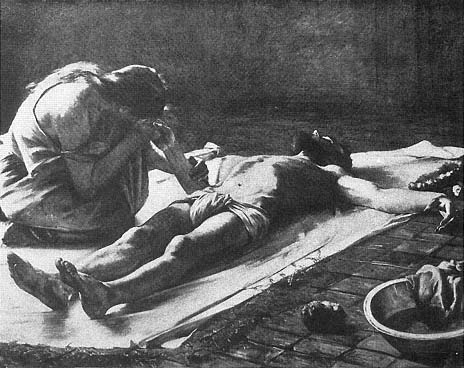
Figure 33
Lovis Corinth, Pietà , 1889. Oil on canvas, 131 × 163 cm, B.-C. 61.
Formerly Kaiser Friedrich-Museum, Magdeburg; destroyed 1945.
Photo: Bruckmann.
submitting a Dead Christ with Angels (Metropolitan Museum of Art, New York) to the Salon in 1864.
In addition to Löfftz's Christ Lamented by the Magdalene (see Fig. 9) and Jean-Jacques Henner's various interpretations of the theme, Corinth may have known Böcklin's Mourning Magdalene (1867; Kunstmuseum, Basel) as well as Trübner's Christ in the Tomb (1874; Bayerische Staatsgemäldesammlungen, Neue Pinakothek, Munich).[28] Like Böcklin and Löfftz he paired the dead Christ with the distraught Magdalene rather than the more conventional figure of Mary. The composition, however, clearly derives from Karl Stauffer-Bern. The diagonally foreshortened figure of the male model, of which Corinth also made a preliminary oil sketch (B.-C. 60), recalls Stauffer-Bern's drawing of 1881 (see Fig. 22), and no doubt the Swiss artist's preoccupation with religious themes during the winter of 1887–88 encouraged Corinth to return to a subject that had first claimed his attention at the Académie Julian.
Seen from above, the pictorial space in the Pietà is coextensive with the viewer's own, setting the stage for an empathic experience. The naturalistic figures, illuminated by the bright light from the upper left, lend the scene a
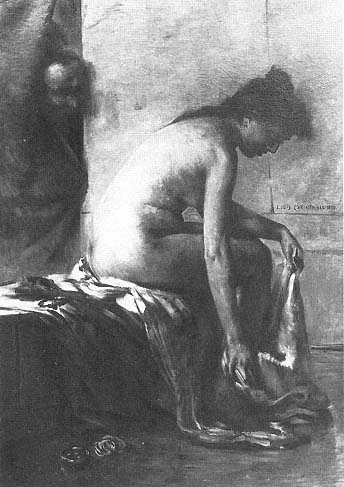
Figure 34
Lovis Corinth, Susanna in Her Bath , 1890. Oil on canvas,
159 × 111 cm B.-C. 74. Museum Folkwang, Essen
(Gertrud und Wilhelm Giradet Familienstiftung) (349).
startling and unsentimental immediacy. Indeed, a closer examination of Corinth's conception reveals less concern for emotive content than for pictorial structure. The complex pose of the Magdalene and the foreshortened figure of Jesus—set off against the white cloth and the pattern of the tiled floor—are too carefully staged to be convincing in more than formal terms. Yet the contrived composition fulfilled Corinth's highest hopes. Having exhibited the painting in Bruno Guttzeit's gallery in 1889, he sent it to the Paris Salon in 1890, where it was not only accepted but awarded the "so ardently desired" mention honorable .[29]
Susanna in Her Bath of 1890, best known today through the somewhat more freely painted but contemporary second version of the picture in the Museum Folkwang (Fig. 34), was also conceived with the typical Salon public in mind and, like the Pietà , can be traced to Corinth's student years in Paris. The composition depends on Henner's painting of the same subject (c. 1863; Musée d'Orsay, Paris), which Corinth knew from the collection in the Musée du Luxembourg. Like Henner's painting, the Susanna is a standard academic study from life that has been given a biblical meaning with the addition of a few anecdotal accessories. The wall in the background and the curtain through which the lecherous bearded elder peeks delimit the pictorial space and provide an effective foil for the nude body of the model.
Emboldened by the favorable reception of the Pietà and possibly hoping to repeat or even improve on his earlier success, Corinth sent the Susanna to the Paris Salon in 1891. This time, however, he was less fortunate, although the painting was accepted—in itself no mean achievement considering the large number of works usually rejected by the jury. No doubt the very acceptance of the painting further convinced Corinth that public approval of his work depended on his producing compositions that demonstrated his technical abilities in the context of a "significant" theme.
The seated male nude in The Prodigal Son (Fig. 35), painted in 1891, is also still recognizable as a studio model, although here the treatment of the anatomy is woefully inadequate. The limbs are far too long, and even the disheveled heap of straw on which the figure sits cannot disguise the awkward connection between the upper and lower parts of the body. There is also a stylistic dichotomy between the meticulous modeling of the flesh parts and the atmospheric rendering of the rest of the picture (the straw-covered ground and the pigs, for example, are sketchily painted). The lower left corner of the pigsty is taken, without modification, from Corinth's early canvas Cowbarn (B.-C. 2), painted at his uncle's farm in Moterau in 1879. Many years later Corinth himself made fun of the technical discrepancies of the 1891
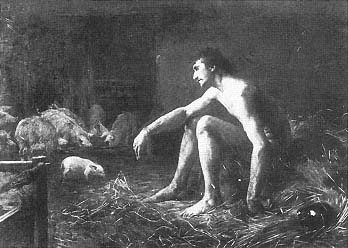
Figure 35
Lovis Corinth, The Prodigal Son , 1891. Oil on canvas,
112 × 154 cm, B.-C. 81. Present whereabouts unknown.
Photo: Marburg/Art Resource, New York.
painting when he confessed in a letter to his wife, written on January 26, 1903, that the pigs were really the best part of the picture.[30]
Despite the stylistic ambiguities and the odd handling of the nude model, the painting is of special interest, for in it Corinth may have intended more than merely to solve an academic pictorial problem within a well-known thematic context. It has been suggested, for instance, that in placing the biblical character in a peasant milieu he knew intimately, Corinth may have reflected his own sense of professional and personal isolation.[31] This suggestion merits serious consideration, for despite the honorable mention awarded him by the Salon jury in 1890, in far-off Königsberg Corinth had not achieved professional security. He exhibited regularly with the Königsberg Artists' Association and at Guttzeit's gallery, to be sure, but critics generally qualified their praise of his work. They commented favorably on his technical skill and acknowledged his success in Paris with a measure of pride. But a critic for the Hartungsche Zeitung , for instance, writing in the May 5, 1891, issue, noted that despite a remarkable technique, Corinth followed the beaten track so lazily that one should expect little of him in the future.[32] Moreover, considering that his father's death had left Corinth without his only moral support, it is not farfetched to assume that the Prodigal Son, remorseful in his loneliness, had a personal meaning for the painter.
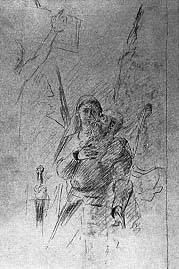
Figure 36
Lovis Corinth, Learn to Suffer
without Complaining , 1891.
Crayon, sheet 52 × 34 cm, image
34.0 × 22.5 cm. Private collection.
Photo courtesy Thomas Deecke.
Although Corinth explored the extended meaning of literary subjects only much later, in one composition at this time, awkwardly titled Learn to Suffer without Complaining , he expressed himself allegorically. Corinth first exhibited the large painting in September 1891, and although it was seen at the Berlin Secession as late as 1918, when the misery of the First World War gave the subject renewed meaning, the only evidence of the picture today is a preliminary sketch (Fig. 36).[33] The title derives from what the German emperor Friedrich III allegedly said to his son Wilhelm, who was born with a crippled arm; the picture itself was apparently inspired by the memory of the tragic and premature death of the emperor in 1888. An enlightened and cultured monarch whose ascension to the throne had been anticipated with great hope by a large part of the German nation, Friedrich died of throat cancer after a reign of only ninety-nine days. In Corinth's preparatory study the emperor, accompanied by an angel, stands beneath the crucifix in the place traditionally reserved for John the Evangelist in religious compositions of this type. Gazing at the cross, the emperor accepts Christ's death with reverence and resignation. In the context of Friedrich's own suffering, the idea that Corinth undoubtedly wished to convey here is that of an imitatio Christi . For the posture and gesture of the emperor as well as the design of the armor, however, Corinth relied again on his memories from Paris, since he took these de-
tails, with little change, from Rubens's painting of the presentation of Marie de' Medici's portrait to King Henry IV of France, part of the famous allegorical cycle now in the Louvre.[34]
Corinth may have had his most satisfying intellectual exchange during these years when the Berlin painter Walker Leistikow spent some time in Königsberg in 1890 working on a panorama of the city. The two men had met briefly in Berlin during the winter of 1887–88. In the course of Leistikow's visit their acquaintance developed into a lasting friendship. Leistikow surely gave Corinth an up-to-date account of recent artistic developments in Berlin. He may also have encouraged him to look anew beyond the borders of East Prussia. Corinth's success with the Pietà in Paris finally seems to have convinced him that Königsberg could never offer him even a remotely comparable forum. Thus in the fall of 1891, having found a custodian for his property, he returned to Munich. By the beginning of October Corinth was settled in a spacious studio at Giselastrasse 7, in the city's Schwabing district. He was not to exhibit again with the Königsberg Artists' Association until 1899.
A Swarming Beehive
In his memoirs Corinth compared Munich's artists' community in the 1890s to a "swarming beehive" whose occupants kept searching restlessly for new territory.[35] This appraisal is confirmed by the architect August Endell, who described with astonishment the seemingly endless variety of works exhibited in the Bavarian capital in 1896:
So many teachers, so many different ways to paint, and theories as plentiful as sand in the sea, one more eccentric and weird than the other. . . . This one wants Greek noses and garments; that one, large philosophical compositions; a third, history paintings; a fourth, village scenes. There are those who insist on plein air and still others who know how to speak profoundly about light and dark. In addition, there is socialism, poor-people painting, mysticism, and symbolism. Everybody has a different ideal.[36]
Diversity, however, was not new to Munich painting in 1896. Although the annual exhibitions at the Glass Palace and the periodic international exhibitions, both sponsored by the conservative Munich Artists' Association, continued to be dominated by the Munich Academy, by the 1880s a number of
fads had made themselves felt, usually begun by artists who had won special acclaim at one of these exhibitions. Bastien-Lepage's painting The Beggar (1881 Salon; Statens Museum for Kunst, Copenhagen), for instance, shown at the international exhibition of 1883, inspired works of social content that haunted many a Schwabing studio until 1887, when the idyllic landscapes of the Scottish painters James Guthrie and David Cameron generated a new fashion.[37] The international exhibition of 1888 still gave prominence to naturalistic subjects, but the following year a new kind of idealism emerged, exemplified by the arresting imagery of Arnold Böcklin. Böcklin, condemned a few years earlier as a "fanatic of the hideous and the bizarre" and reviled for depicting "coarse, base emotions reminiscent of the lowest strata of human sensuality,"[38] showed seventeen paintings at the Glass Palace, including his fierce Battle of Centaurs (1873; Öffentliche Kunstsammlung Basel, Kunstmuseum). The 1889 exhibition marked the beginning of Böcklin's fame. Soon he was compared to Goethe, Beethoven, Rembrandt, and Phidias and celebrated as the "Shakespeare of painting."[39] The Böcklin cult ultimately reached ridiculous proportions. Soon after the painter's death in 1901 the Berlin critic Hans Rosenhagen wrote with unsurpassed hyperbole: "Böcklin was a hero, he belonged to a divine race[,] . . . he is eternal . . . [and] stands lonely above mankind. Past, present, and future merge in his heart. An extension of the cosmos, he encompasses all being."[40]
At the same exhibition in 1889 the young painter Franz von Stuck won a gold medal and a prize of sixty thousand marks for his Guardian of Paradise (1889; Stuck-Jugendstil-Verein, Munich). Whereas Böcklin's naturalism invests his hybrid mythological creatures with an astonishingly real, palpable presence, Stuck's synthesis of the real and the ideal in subject and form relies on naturalistic devices and emblem-like simplifications. The space in his painting is at once atmospheric and flat; the figure of the angel is carefully modeled yet silhouetted as a bold, simplified design. Although Stuck soon followed Böcklin's example and produced a series of strikingly naturalistic images of nymphs, satyrs, and fauns, he also continued in such works as the demonic Sin (Bayerische Staatsgemäldesammlungen, Neue Pinakothek, Munich), painted in 1893, to employ—as in Guardian of Paradise —a mixture of naturalism and stylization.
During the 1890s the reputation of Klinger and Uhde also rose. Only a few years earlier their ideal subjects had been greeted with skepticism because, like Böcklin's, they did not meet conventional standards of beauty.
Böcklin, Klinger, Uhde, and Stuck suddenly became popular during the last decade of the nineteenth century because these artists satisfied a bur-
geoning need for a "heightened" reality that was part of a broad antiscientific movement in both art and philosophy. This development, eventually felt throughout Europe, originated in France. As early as 1884 the novelist and critic Joris-Karl Huysmans has des Esseintes, the hero of his novel A rebours , raise an angry voice against the contemporary infatuation with naturalism: "Nature has served her purpose [and] by the disgusting uniformity of her landscapes and her skies has . . . worn out the attentive patience of the refined. . . . the time has come when nature should be replaced with artificiality as far as possible."[41] Two years later Jean Moréas's manifesto Le symbolisme turned against naturalistic writers such as Emile Zola by announcing the advent of literary symbolism in French literature. Like Henri Bergson, who believed intuition the fundamental source of human knowledge, Moréas and his friends were convinced that only the world of ideas offered artists the superior reality they were charged to evoke and to depict. In Germany the novelist and playwright Hermann Bahr echoed this belief when he informed his readers in 1891: "The rule of naturalism is over, its time is up, its magic dispelled, . . . we want to get away from naturalism and reach beyond it."[42] With growing frequency German critics joined the refrain. "Tear off the materialistic blinders; let allegory, the stories of the Bible, Homer be our guides in a world of greater beauty and lofty thought."[43]
Despite the similarity of the rhetoric, these ideas manifested themselves in French and German painting in fundamentally different ways. Whereas most French Symbolists reacted against Impressionism, a movement that had never taken root in Germany, German idealists rebelled against naturalistic and academic landscape and genre painting. Because German artists bypassed the critical intervening stage of Impressionism, with concern for bright color and simplified design, many of their works from the 1890s are ambivalent. Some of them began by emulating Stuck's precarious synthesis and eventually embarked on a process of rigorous stylization that was to culminate in the German Jugendstil version of art nouveau. Many others followed the new vogue for the meaningful theme, but, like Böcklin, Uhde, and Klinger, clothed their ideal subject matter in the naturalistic form prevalent during the preceding decades.
In Munich these diverse trends acquired an unexpected forum with the founding of the Munich Secession in 1892,[44] an event that plunged Schwabing's artists' community into turmoil. The Munich Secession brought together artists dissatisfied with the exhibition policies of the Munich Artists' Association, policies jealously guarded by the city's "painter prince" Lenbach. They felt that the annual exhibitions at the Glass Palace were unjustifiably parochial
and included far too few works of true merit. Foreign artists, for instance, were invited only to the special international exhibitions that were generally held every four years. The Secessionists had three major goals: smaller exhibitions, works of higher quality, and annual participation by artists from abroad without regard to their form of artistic expression. The founding members of the Munich Secession were themselves a heterogeneous group. They included, besides Uhde and Stuck, Peter Behrens, Otto Eckmann, Thomas Theodor Heine, Adolf Hölzel, and Wilhelm Trübner. Their first exhibition, which opened June 15, 1893, in a newly erected building at the corner of Prinzregentenstrasse and Pilotystrasse, featured, in addition to their own work, paintings by such diverse artists as Böcklin, Liebermann, Puvis de Chavannes, Degas, Monet, and Carrière. In short, the Munich Secession accommodated virtually everything from Realism, Naturalism, and Impressionism to Symbolism and the budding Jugendstil movement.
Petty jealousies explain why several Secessionists, including Behrens, Eckmann, Heine, Trübner, and Schlittgen as well as Carl Strathmann and Max Slevogt, decided later the same year to form a separate Free Association.[45] Through Eckmann they secretly arranged with their old enemy, the Munich Artists' Association, to exhibit independently as a group under the auspices of the association's official program at the Glass Palace. When these plans were discovered, the Munich Secession reacted sharply to the defection and promptly purged its ranks of the offenders. Under pressure from conservative members, the Munich Artists' Association, in turn, was forced to withdraw its permission to exhibit at the Glass Palace, and the renegades thus found themselves between opposing camps. The Free Association was never successful. It held one exhibition in Munich and another, in the fall of 1894, at the gallery of Fritz Gurlitt in Berlin. Interestingly, future exhibitions were to have included a number of French painters of the avant-garde, as Eckmann informed Trübner in a letter dated February 21, 1894. According to this letter, Eckmann had contacted two indépendants who had promised to arrange for the submission of works by Anquetin, Toulouse-Lautrec, Gauguin, Denis, and others.[46] Although these names reveal Eckmann's own antinaturalist bias, the Free Association too was made up of artists pursuing a wide range of pictorial expression. Eckmann, whose work showed a growing tendency toward Jugendstil , and Trübner, a realist in the Leibl tradition, merely represent the divergent poles.
No wonder Corinth, who had just left the staid provincialism of Königsberg, compared the Munich art scene to a "swarming beehive." And as if his creative energy had been dammed up far too long, he joined passionately, if
not altogether altruistically, in the controversies surrounding the Munich Secession and the ill-fated Free Association. "I was happily carried along in this stream," he recalled in his memoirs, "proud to be respected as yet another voice. Moreover, I had the intuitive feeling that as part of this clique I would be able to get ahead."[47]
As a founding member of both the Munich Secession and the Free Association, Corinth entered on a period of cultural politics that for the first time in his career not only brought him face to face with a variety of modern trends but also placed him in a competitive situation bound to make him keenly sensitive to the goals of his own art. The fiasco of the Free Association gave added direction to his intellectual development. After that episode had pitted him against both the Munich Artists' Association and the Munich Secession, he found more congenial company in the literary world. One of his closest friends at this time was the Bavarian satirist Joseph Ruederer, who lived one floor below Corinth's studio on Giselastrasse. Ruederer himself was the center of a lively literary circle that included Max Halbe, Otto Erich Hartleben, Eduard von Keyserling, and Frank Wedekind. The novels and plays these men wrote were often given a first reading at informal gatherings. Corinth, for instance, was present at the Café Minerva when Wedekind read from his play Sonnenspektrum , and he also attended the tumultuous premier of Erdgeist , the first of Wedekind's Lulu plays. Corinth's own impulse to write, which eventually developed into a lifelong labor of love, clearly dates from these years, for he began the first draft of his autobiography in 1892.
Corinth's output increased markedly in the 1890s, and the works he produced then reflect the artistic and intellectual milieu in which he lived. They are indebted to several different models and vary greatly in subject matter, conception, and execution. They also contain the seeds of elements that by the end of the decade constituted the main features of a distinct style: a highly energized and mood-inducing painterly treatment, audacious eroticism, and deep psychological insight.
Diogenes
Corinth's first major painting from Munich, Diogenes (see Plate 4), was the most ambitious composition he had ever attempted, with no fewer than twelve almost-life-size figures. Although the canvas bears the date 1892, Corinth must have begun work on it soon after his arrival from Königsberg, for
the picture was being exhibited at the Munich Glass Palace by the end of 1891. The painting depicts the Cynic in the Athenian marketplace, his lamp lit in daylight, as he searches "for an honest man." The subject was especially popular in seventeenth-century Flemish painting. Jordaens depicted it several times, most notably in the large canvas now in Dresden. Corinth's version, however, recalls a lost composition by Rubens, a workshop copy of which is preserved in the Louvre. Corinth's intention to demonstrate again, as in the Pietà , his mastery of a large figure composition is evident from the calculated grouping of the figures so as to achieve a variety of postures and textures. Diogenes stands alone, holding up his lamp; the reactions of the eight figures before him range from amused curiosity to outright derision. The postures and gestures of the two naked urchins in the left foreground are sequential, the one leaning forward, supporting his hands on his knees, the other standing upright with arms upraised. The young woman in the center continues the movement, leaning back as she shields her mocking expression with her forearm. The picture opposes old faces to young ones, clothed figures to nudes. Diogenes' weathered old skin contrasts with the youthful skin of the two boys before him. The simplified figures of the nude children in the background similarly correspond to one another. As in the Pietà , the figures are illuminated by a strong light from the upper left. Rejecting the idealism with which subjects like this one were traditionally rendered, Corinth, moreover, went so far as to introduce figure types that might have been found in a Munich market square in the 1890s: the old woman with the basket and the couple standing at the far left. In recasting the subject in a naturalistic form, Corinth, like Böcklin, did not hesitate to translate the heroic into the commonplace. And Corinth's Diogenes , like Böcklin's work, was not accorded an entirely favorable reception. Indeed, one critic was so horrified by the bluish skin tones of Corinth's figures that he warned of the imminent demise of German art.[48]
Belated Responses to Munich Realism
The events surrounding the founding of the Munich Secession in 1892 brought Corinth into close contact with Wilhelm Trübner. Trübner, the only painter of the original Leibl circle still working in Munich, willingly shared his insights and knowledge with younger colleagues. As Corinth wrote in an article first published in 1913, he came to regard Trübner almost as a teacher: "I could
almost pride myself having been his pupil, if one can so call a relationship in which the older artist, drawing on his rich experience, generously gives advice to the younger, who respectfully follows such counsel."[49]
Through Trübner, Corinth was finally introduced to Munich realism of the 1870s, and several of his paintings from 1892 attest to this belated encounter with the Leibl tradition. One of these is the portrait of the landscape painter Benno Becker (see Plate 5). The modeling, especially in the face, is firm, and the dominating gray and white tones are subtly nuanced. Like Leibl's reverie pictures, which are themselves indebted to such French antecedents as Courbet's After Dinner at Ornans (1848; Musée des Beaux-Arts, Lille), the painting is half portrait and half genre subject. The sitter's actions emphasize the anecdotal conception of the painting, in contrast to Corinth's two preceding artist portraits of Carl Bublitz and Hugo Rogall (see Figs. 30, 31), in which the postures and gestures underscore the Bohemian character of the individuals portrayed. Yet the 1892 portrait does not lack characterization. The comfortable ambience reinforces the easygoing manner of the sitter; his amused expression suggests a perceptive, if somewhat irreverent, intelligence. Virtually forgotten today, Benno Becker (b. 1860), a native of Memel, was about two years younger than Corinth and played an active role in the Munich artists' community in the 1890s. He was the secretary of Allotria, the social club of the Munich Artists' Association, and later served as secretary of the Munich Secession. He had studied archaeology and art history and also had literary ambitions, writing for both Die Freie Bühne and Pan . His contributions to the festivities at Allotria include a parody of Goethe's famous Faust monologue that casts Corinth in the role of the seeker of knowledge and truth—pursuing far more earthly pleasures than Goethe describes.[50]
Corinth's encounter with the legacy of the Leibl circle led him to rededicate himself to subjects inspired by his environment and heightened his awareness of pictorial realism as a function of the medium itself. Several of his paintings from 1892 are technically similar to the portrait of Benno Becker. They include Woman from Dachau Knitting (B.-C. 93) and Old Men's Home in Kraiburg (B.-C. 94), both of which evoke the stillness and rural simplicity that pervade the interiors Leibl had painted during the 1870s and 1880s in Bavarian villages. Other paintings signal a growing reliance on a rapid, sketchy execution that, while still in the service of description, plays more than a purely illustrative role. At the Breakfast Table (Fig. 37) is one of these pictures. Here the paint has been applied freely, and the shapes have been simplified and blocked out in bold brushstrokes. Corinth painted the picture during one of his visits to the small Bavarian town of Dachau, where in 1888 Arthur Lang-hammer together with Adolf Hölzel and Ludwig Dill had founded the artists'
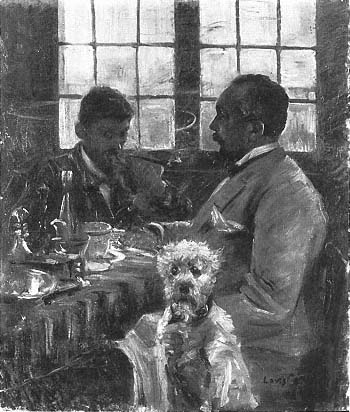
Figure 37
Lovis Corinth, At the Breakfast Table , 1892.
Oil on canvas, 113 × 95 cm, B.-C. 92.
Private collection.
Photo courtesy Eberhard Ruhmer.
group Neu-Dachau. The painting ostensibly depicts Arthur Langhammer (1855–1901), at left, in the company of another painter named Brand,[51] whose identity, however, is not known. What interested Corinth here was neither the individuality of the two men nor the specifics of the setting but the atmospheric ambience of the room, whose smoky air is as tangible as the light that reflects off the objects on the table. Seen against the bright expanse of the window, the faces of the sitters show relatively little detail. Only Langhammer's dog Hipp, whom Corinth commemorated the same year in a separate painting (B.-C. 91), retains his characteristic expression and appearance.[52]
In the small picture of a slaughterhouse interior (see Plate 6) the sketchy brushwork acquires the visceral expressiveness now recognized as a distinctive feature of Corinth's mature style. Although the painting emphasizes the physical action of the butchers who skin and dress the slaughtered animals, their activity is subordinated to the life of the colors, shades of red shot through with blue, green, yellow, and white. The suspended carcasses dominate the composition, and the swirling brushstrokes, as suggestive as they are descriptive, unify the canvas. In the bright light from the window at the back of the room, the blood rising from the floor and the opalescent entrails give off palpable heat and smells.
First Major Landscapes
Corinth's tendency to subordinate individual forms to a larger whole may have been a consequence of his growing interest in landscape painting. For in outdoor light he faced a wealth of nuances that demanded to be unified within a broad spatial concept. He responded with vibrant tones that translate light and atmosphere into elements of pictorial energy. Corinth's earlier landscapes are informal studies, undertaken largely as exercises. His landscapes from the 1890s, by comparison, result from a serious and sustained commitment to plein air painting.
Corinth's major landscapes begin with the view he painted in the autumn of 1891 from the window of his studio (see Plate 7). With this painting he continued the German Romantic theme of the "open window," though his reinterpretation of the subject is prosaic, like Menzel's window views in Berlin and Winterthur. Across the gardens and fields that at the time gave Schwabing a rural character, the view extends to church towers and smoking chimneys in the distance. White patches of an early snow intermingle with the green of the meadows, and in the humid air the soil and trees take on a reddish tone. The simplified composition evolves from variations of the surface texture, and both the direction of the brushstrokes and the impasto of the swiftly applied patches of color suggest that the motif was constructed right on the canvas.
Most of Corinth's landscapes from this time were painted during the summer months he spent in the picturesque countryside near Munich. They show a considerable debt to the paintings of the Barbizon school, which after the international exhibition in 1869 had helped to redirect Munich landscape painting, encouraging a more intimate conception of nature in contrast to the
Dutch-inspired vistas popular during the first half of the century. The painters of the Leibl circle, in particular, gave the simplest motif—a clearing in the underbrush or a cluster of shrubs and trees by a brook or a pond—careful and sympathetic attention. Corinth's forest interiors from this time show a similarly circumscribed view. One, the splendid picture now in Dachau (Fig. 38), is painted so freely that the canvas is almost a flickering patchwork of brushstrokes. The others are more controlled and elegiac in mood. The technical and expressive range of these landscapes is illustrated by the painting in Dachau and the Large Landscape with Ravens (Fig. 39) of the same year. The forest scene is a spontaneous visual response to the evanescent effect of bright sunlight breaking through foliage; the landscape indicates a more deliberate approach, with its simplified composition and the predominant shades of purple that reinforce the autumnal mood. As in Caspar David Friedrich's well-known picture in the Kunsthalle in Hamburg, Hill and Ploughed Fields near Dresden (c. 1830s), which Corinth's landscape also resembles structurally, the ravens settle on the harvested fields like harbingers of winter and approaching death.
Corinth's melancholy conception was apparently inspired by the moody landscapes of Walter Leistikow (1865–1908), with whom he sometimes painted in the fall of 1893 near Dachau and at the Starnberger See. Earlier in the year Leistikow had been to Paris, where he was deeply moved by a performance of Maurice Maeterlinck's Pelléas et Mélisande at Lugné-Poé's newly opened Théâtre de l'Oeuvre. Summarizing his impressions of the play, he wrote in the July issue of Die Freie Bühne : "I do not know of anyone who can wield the brush better than this poet. His works are spoken painting. And this performance is one of the greatest works of painting the modern period has brought forth."[53] At the time, Leistikow himself was in the process of abandoning his naturalistic approach to landscape painting in favor of a more evocative rendering. Using simplified patterns of muted colors, he gradually evolved a pictorial language that conveys a gentle and somber mood, as in his landscapes of the Grunewald (Fig. 40), in which dark groups of trees stand silently, silhouetted against the sky and reflected in the waters of a quiet lake or pond.
Leistikow's influence is also evident in the haunting Fishermen's Cemetery at Nidden (see Plate 8), painted in the summer of 1894 when Corinth traveled to East Prussia and the Baltic seashore. The melancholy character of the painting derives not only from the motif but also from the pictorial elements. As in the autumnal landscape in Frankfurt, purplish tones dominate the variegated colors of the sandy soil. Most of the crosses are painted in somber shades of blue
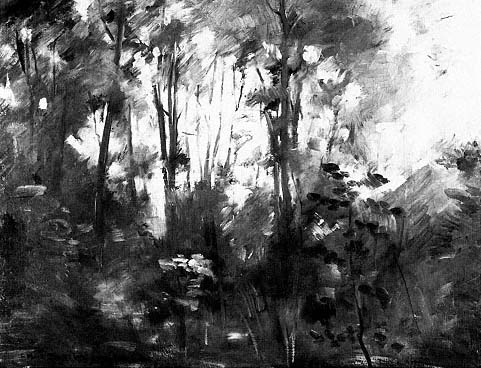
Figure 38
Lovis Corinth, Forest Interior near Dachau , 1893. Oil on canvas, 67 × 86 cm, not in B.-C.
Kunstsammlungen der Stadt Dachau.
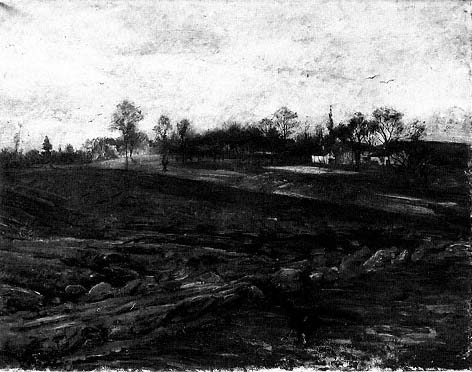
Figure 39
Lovis Corinth, Large Landscape with Ravens , 1893. Oil on canvas, 94.5 × 120 cm,
B.-C. 100. Städelsches Kunstinstitut Frankfurt (1912).
Photo: Ursula Edelmann.
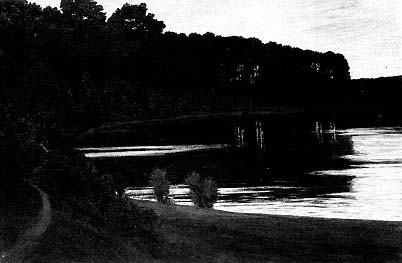
Figure 40
Walter Leistikow, Lake in the Grunewald , c. 1895. Oil on canvas,
167 × 252 cm, Staatliche Museen zu Berlin, National-Galerie (DDR).
and brown. Only one grave is still tended; the others lie neglected. Here and there flowers survive among the weeds. There is a strangely anthropomorphic quality to the crosses, which almost seem to gaze out to sea. As in the paintings by Caspar David Friedrich in which human figures, seen from the back, stand transfixed before nature, the viewer's feelings are directed beyond the graves to the open water, where boats glide smoothly along the shore.
Otto Eckmann and Carl Strathmann
Leistikow's evocative approach to landscape painting touched Corinth at a point in his development when two other friends, Otto Eckmann (1865–1902) and Carl Strathmann (1866–1939), both members of the Munich Secession and subsequently the Free Association, were evolving a radically simplified vocabulary of form. Although Corinth's own creative impulses pointed toward an ever more energetic naturalistic conception, he had some sympathy for his friends' increasingly linear inventions.
Eckmann's early paintings are landscapes similar to Leistikow's in form and expression. But after 1890 he simplified the forms of nature in a way that reveals a strong predilection for ornament. The Four Ages of Man (present where-abouts unknown), six panels completed in 1894, was one of his most ambitious works. To demonstrate the parallelism between the life of nature and of man, Eckmann set each of the four inner scenes in an appropriate season of the year and in the outer panels depicted emblematic images of the beginning and end of life: a young plant rising under the first rays of the springtime sun and a dying plant in a winter landscape. With naturalistic modeling and emphatic contours Eckmann trapped the individual forms in a shallow, tapestry-like space. The Four Ages of Man turned out to be his last painting. In 1893 Justus Brinckmann, then director of the Museum for Arts and Crafts in Hamburg, had introduced Eckmann to Japanese woodcuts. Their simplified drawing and compositional devices so affected the painter that on November 27, 1894, he auctioned off his entire oeuvre and devoted himself henceforth to the art of graphic design. Many of his woodcut illustrations were published in such journals as the erudite quarterly Pan and the popular Munich weeklies Jugend and Simplizissimus . From evocative lines and arabesques Eckmann developed a repertory of forms that came to be known as floral Jugendstil because of its stylized flowers and plants. The style influenced a host of German designers.[54] According to Ahlers-Hestermann, Eckmann had read Schopenhauer, Nietzsche, and Kant and in general was "spiritually more demanding than his easily satisfied colleagues."[55] An analogous pictorial rigor distinguishes
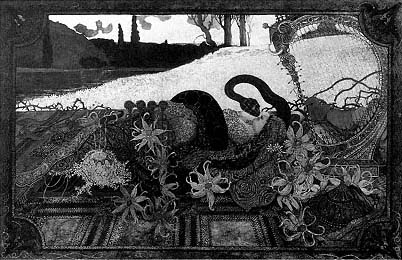
Figure 41
Carl Strathmann, Salammbô , 1894–1895.
Mixed media on canvas, 187.5 × 287.0 cm.
Kunstsammlungen zu Weimar.
Eckmann's abstractions, especially in comparison with the bizarre imagery of Carl Strathmann.
Strathmann's curious work occupies an intermediate position between the art of painting and the crafts. His paintings are strange concoctions studded with colored glass and artificial gems, foreshadowing similar extravagances by the Viennese Jugendstil painter Gustav Klimt. In Strathmann's painting Salammbô (Fig. 41), inspired by Flaubert's novel, the Carthaginian temptress reclines on a carpet spread out on a flower-strewn meadow. Swathed in veils whose design is as complex as that of the harp beside her head, she submits to the kiss of the mighty snake that encircles her. Corinth described how Strathmann, while working on the large picture, gradually covered the originally nude model with "carpets and fantastic garments of his own invention so that in the end only a mystical profile and the fingers of one hand protruded from a jumble of embellished textiles. . . . colored stones are sparkling everywhere; the harp especially is aglitter with fake jewels." According to Corinth, Strathmann knew "how to glue and sew" these on the canvas "with admirable skill."[56]
Tragicomedies
As Corinth's three closest friends embarked on their individual pictorial explorations, Corinth himself experienced a minor crisis that made him unusually receptive to their experiments. Still dissatisfied with his handling of anatomy in Diogenes and the Pietà , he felt he needed further practice in drawing from the live model. Eckmann, whom Corinth fondly remembered as his "spiritus rector," who supported and steadied him whenever he was in danger of losing his footing,[57] suggested that he try making some prints; Corinth began a series of studies that eventually resulted in his first graphic cycle, Tragicomedies , nine etchings completed in 1893 and 1894. Working "daily, for months on end, . . . with individual figures and groups of several models," he was so taken with this project that he, too, was tempted to give up painting for good.[58] Corinth had in mind for the cycle motifs of "eccentric originality," as he put it, with which he hoped to astonish and impress his colleagues.[59] His professed intention explains both the odd emblematic details in some of the compositions and the farcical tone that turns each episode into a true tragicomedy, no matter how serious the subject. The cycle has no thematic unity. Instead, the illustrations follow in random succession.
The first etching in the series, Walpurgis Night (Fig. 42), is based on Goethe's description of the witches' nocturnal ride to the Brocken, their annual meeting place in the Harz Mountains. Faintly visible in the background, old Dame Baubo on her sow and several other shadowy figures on brooms hurry through the sky as four youthful witches, accompanied by a flock of ravens, encircle a skull suspended in midair. A shooting star streaks through the sky at the upper right. Surviving drawings for the cycle indicate that Corinth prepared the etchings with considerable care. He began with quick preliminary sketches and then drew the individual figures from the model, subsequently incorporating these studies into a more finished composition drawing for transfer to the copper plate. In Walpurgis Night the postures of the floating witches can still be recognized as positions assumed by the models in the studio, standing, sitting, or lying down. There is special emphasis on the contours, and strong contrasts of light and shade render the major figures fully tangible. The composition itself, however, is simplified and derives its effect from the silhouette formed by the interlocking figures. This stylistic ambivalence recalls Stuck's Guardian of Paradise , and in the second etching of the cycle, Paradise Lost (Fig. 43), the angel's arm from Stuck's painting reappears with only minor modifications. As in the preceding print, the fully modeled figures form a striking pattern against the white paper ground.
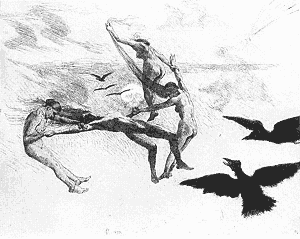
Figure 42
Lovis Corinth, Tragicomedies: Walpurgis Night , 1893.
Etching, 34.2 × 41.7 cm, Schw. 5 II.
Graphische Sammlung Albertina, Vienna (1910/406/5).
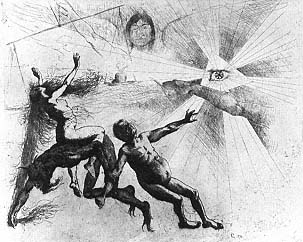
Figure 43
Lovis Corinth, Tragicomedies: Paradise Lost , 1893.
Etching, 35.0 × 41.8 cm, Schw. 5 III.
Graphische Sammlung Albertina, Vienna (1910/406/4).
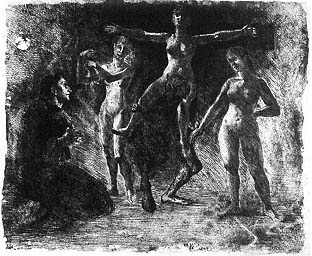
Figure 44
Lovis Corinth, Tragicomedies: The Temptation of
Saint Anthony , 1894. Etching, 34.3 × 42.2 cm., Schw. 5 IV.
Graphische Sammlung Albertina, Vienna (1910/406/8).
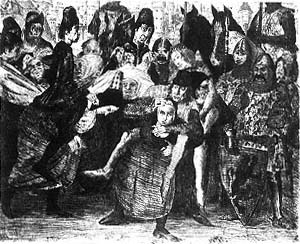
Figure 45
Lovis Corinth, Tragicomedies: The Women of
Weinsberg , 1894. Etching, 35.0 × 42.5 cm, Schw. 5 VII.
Graphische Sammlung Albertina, Vienna (1910/406/6).
Here, however, the stylistic ambiguity of the composition is intensified by the emblematic imagery: a large eye in the center of a triangle, symbolizing the Holy Trinity, radiates beams of light; the powerful arm of an otherwise unseen angel brandishes a flaming sword; and the figure of Saint Michael holds aloft the scales that weigh the moral frailty of the human heart.
Three of the five remaining narrative episodes of the cycle have greater stylistic unity. In each of these the naturalistic portrayal of the figures is matched by an appropriately atmospheric setting. The Temptation of Saint Anthony (Fig. 44) was clearly inspired by Félicien Rops's woodcut of the same subject. The elongated faces and caps of the men in The Women of Weinsberg (Fig. 45) recall similar features in paintings by Dirk Bouts. This print depicts the amusing story told about the siege of the Bavarian town of Weinsberg in 1140, when the Hohenstaufen enemy Conrad III accepted the surrender of the town on the understanding that only the women would be spared; they were allowed to leave the town with whatever they could carry. The resourceful women met the conditions of the agreement by marching forth with their husbands on their backs. In the more familiar subject Marie Antoinette on Her Way to the Guillotine (Fig. 46) the unfortunate queen sits stiffly upright in a cart surrounded by a jeering mob. This print would seem to presuppose knowledge of the famous sketch, now in the Louvre, in which Jacques Louis David recorded Marie Antoinette's last journey.
The tension between naturalistic modeling and flat decorative elements is again evident in Joseph Interprets the Pharaoh's Dreams (Fig. 47) and Alexander and Diogenes (Fig. 48). Amid the splendor of the king's palace Joseph strikes a lively pose as he interprets the dreams of the seven lean years of corn following the seven abundant years. The idea of illustrating the dreams in the diaphanous roundels visible in the archway may have been inspired by Peter von Cornelius's painting of the same subject in the fresco cycle for the Casa Bartholdy in Rome, transferred to the National Gallery in Berlin around 1886. The story of Alexander's encounter with Diogenes is told by Plutarch and Diogenes Laërtius, both of whom describe how Alexander once invited the philosopher to ask any favor. Diogenes, who despised all worldly possessions to the extent of making his home in a tub, requested that Alexander step aside, since the king was shading him from the sun. The rigid figures of Alexander's soldiers form an ornamental screen behind the two men—an amusing contrast with their own relaxed postures. Analogous contrasts in the other prints produce the same effect. For example, against the noble emblem of the all-seeing eye of God the fat figures being carried off by Lucifer appear doubly grotesque; the repose of Pharaoh and his queen intensifies the lively gestures
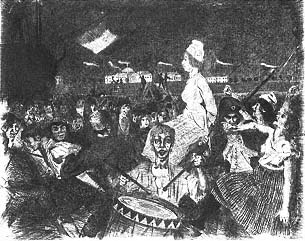
Figure 46
Lovis Corinth, Tragicomedies: Marie Antoinette on Her
Way to the Guillotine , 1894. Etching, 35.0 × 42.3 cm, Schw.
5 VIII. Graphische Sammlung Albertina, Vienna (1910/406/7).
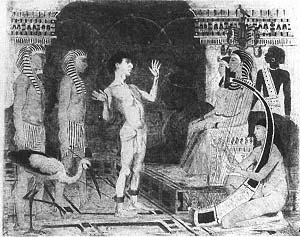
Figure 47
Lovis Corinth, Tragicomedies: Joseph Interprets the
Pharaoh's Dreams , 1894. Etching, 34.4 × 42.3 cm, Schw.
5 V. Landesmuseum Mainz, Graphische Sammlung.
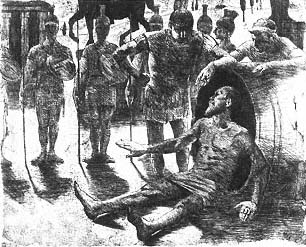
Figure 48
Lovis Corinth, Tragicomedies: Alexander and Diogenes ,
1894. Etching, 34.8 × 42.3 cm, Schw. 5 VI.
Städtische Galerie im Lenbachhaus, Munich.
of the jabbering Joseph; and there is no doubt that the hefty women of Weinsberg are fully up to the task of rescuing their skinny husbands, while Marie Antoinette seeks to preserve an air of dignity amid the throng.
The title page of the cycle (Fig. 49) is the most stylized of the nine etchings and sets the tone for the mocking conception that underlies the individual episodes. Within a frame of predominantly geometric design, Clio, the muse of history, lifts a curtain to reveal a human skeleton. In the surmounting arch an enormous face appears, seen from below in strong foreshortening, its large nose sniffing greedily at a blossom that rises from the panel below. The arbitrary choice of the themes is summed up in the closing vignette (Fig. 50). Here a spider in the center of a web contentedly surveys its catch: the flies trapped in the threads.
Two rapidly sketched pencil drawings now in East Berlin, The Rape of the Sabine Women and The Prodigal Son , belong to the themes from which Corinth assembled Tragicomedies , although the episodes themselves were not included in the cycle. They illustrate the kind of first ideas that preceded the etchings. Of the two, The Prodigal Son (Fig. 51) shows especially well that a humorous conception guided Corinth from the beginning, for here his last painting from Königsberg (see Fig. 35) has been turned into a ludicrous persiflage.
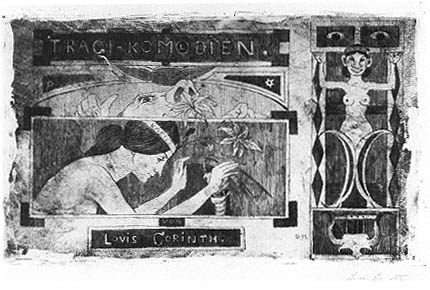
Figure 49
Lovis Corinth, Tragicomedies : Title Page, 1894. Etching, 21.0 × 34.5 cm,
Schw. 5 I. Städtische Galerie im Lenbachhaus, Munich.
It has been suggested that the etchings of Tragicomedies were influenced by Max Klinger's treatise Malerei und Zeichnung (Leipzig, 1891),[60] in which the expressive properties of painting are distinguished from those of the graphic arts. The eccentric character of the cycle indeed suggests that Corinth was familiar with Klinger's idea that whereas painting is bound to the material aspects of things, drawing offers the freedom of poetic license.[61] It is logical to assume that as Corinth learned the technique of etching, he familiarized himself with the thinking of a recognized master in the field. Moreover, since meeting Klinger in Berlin in the winter of 1887–88 he most likely followed his work with interest and knew some of the views Klinger expressed privately, such as the notion that by "placing a carefully modeled object against an undefinable or neutral background," the graphic medium could "depict elements of fantasy that painting can command only under certain conditions."[62] Both Walpurgis Night and Paradise Lost reflect that approach. But even though the cycle conforms to Klinger's contention that "all graphic artists develop in their work a notable tendency toward irony, satire, and caricature,"[63] Corinth clearly did not share Klinger's underlying ethical disposition. Klinger believed that graphic artists "prefer to accentuate weaknesses. . . . from their work rises nearly always one fundamental chord: the world should not be like
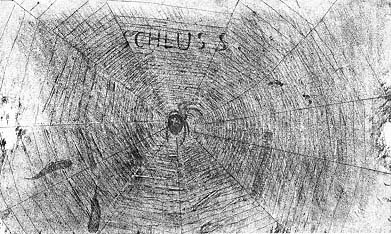
Figure 50
Lovis Corinth, Tragicomedies : End Page, 1894. Etching, 21.0 × 34.9 cm,
Schw. 5 IX. Graphische Sammlung Albertina, Vienna (1910/406/9).
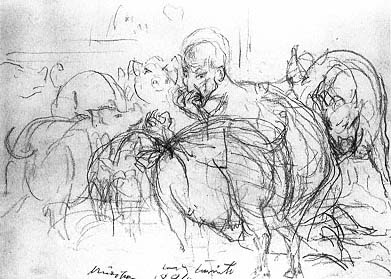
Figure 51
Lovis Corinth, The Prodigal Son , 1894. Pencil, 25.6 × 34.4 cm.
Staatliche Museen, Berlin (DDR) (11/6291).
this!"[64] As Corinth himself admitted, Tragicomedies was not meant to be critical but "eccentric," and—as the concluding vignette of the cycle illustrates unequivocally—he never pretended to have selected his motifs out of a deeply felt ethical commitment.
In the final analysis, Tragicomedies marks an important stage in Corinth's development, for in this cycle he first found the irreverent tone that was to set his mature figure compositions apart from his plodding student work. And he soon learned that the "eccentric originality" with which he had intended to astonish and impress his fellow artists in Munich could also gain him the attention of the public at large. When Corinth exhibited the etchings at Eduard Schulte's gallery in Berlin in the winter of 1894–95, one critic went so far as to rank him with Max Klinger as a printmaker. Calling Corinth a "visionary realist," the same critic praised the cycle for its "raw and instinctual naïveté."[65]
The Temptation of Jugendstil
Whereas the Tragicomedies cycle remains for the most part stylistically ambivalent, a large number of postcards, addressed to Joseph Ruederer and now preserved in the manuscript collection of the Municipal Library in Munich, illustrate the extent to which Corinth allowed himself to be seduced by the radically simplified pictorial language of Eckmann and Strathmann. Datable to the years 1896 to 1898, some of these postcards also bear greetings from Strathmann and may well have been illustrated in collaboration with him (Figs. 52, 53). A strong element of design is common to most of the imagery, as well as a naive, at times even coarse, humor that suggests caricature played an important part in Corinth's exploration of the formal idiom of Jugendstil . In a whimsical sketch of about 1896 (Fig. 54), which shows the full-length figure of Benno Becker, a self-portrait in the upper right, and the heads of two other painter friends, Friedrich Wahle (1863–1927) in the upper left and Hermann Eichfeld (b. 1845) in the lower right, Becker's countenance has been transformed into a bizarre configuration of curvilinear patterns and capricious arabesques. Though far removed from the trenchant characterizations of Thomas Theodor Heine and Olaf Gulbransson, whose irreverent parodies appeared regularly in Jugend and Simplizissimus , the caricature nonetheless approximates their sophisticated use of line.[66]
Ordinarily Corinth's modified naturalism took a less extreme form. In Faun and Nymphs (Fig. 55), one of several illustrations he published in the early is-
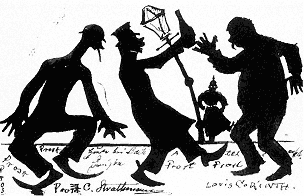
Figure 52
Lovis Corinth (and Carl Strathmann?), Postcard to
Joseph Ruederer, 1897. Pen and ink, 8.9 × 14.0 cm.
Stadtbibliothek, Handschriften- und
Monacensia-Abteilung, Munich.
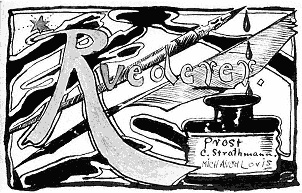
Figure 53
Lovis Corinth, Postcard to Joseph Ruederer, 1897.
Pen, brush, and ink, 8.9 × 14.0 cm. Stadtbibliothek,
Handschriften- und Monacensia-Abteilung, Munich.
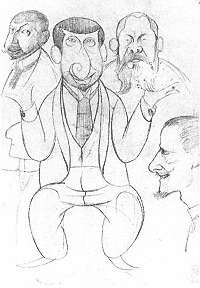
Figure 54
Lovis Corinth, Caricatures , c. 1896.
Pencil, 32.6 × 23.7 cm. Formerly
Collection Johannes Guthmann,
Ebenhausen; present whereabouts
unknown.
Photo courtesy Hans-Jürgen Imiela.

Figure 55
Lovis Corinth, Faun and Nymphs , 1896. Pen and ink.
From Jugend , November 28, 1896, p. 456.
Photo: Horst Uhr.
sues of Jugend , the landscape has been reduced to a flat background, but the figures, even though there is little modeling, retain mass and weight. They are bound by emphatic contours and linked by a measured flow of gestures, resulting in a eurythmic movement that is predominantly decorative in effect.[67] Closely related to the drawings for Jugend are Corinth's illustrations for a collection of short stories by Joseph Ruederer, entitled Tragikomödien , published in 1897. In the vignettes simplified figural motifs based on silhouetted forms are framed by floral borders. The full-page illustrations to the individual stories are less stylized but always accentuate the two-dimensional character of the pictorial field.[68]
In Resurrection (Fig. 56), one of two closely related drawings of this subject from 1896, Corinth applied the same decorative convention to the biblical motif. The horizontal tomb, placed before a simplified landscape, is guarded by three sleeping soldiers. Supported by two flanking angels, Christ stands in the center, erect and with arms outstretched, his attenuated body compartmentalized as in stained glass or cloisonné enamel. All the figures float weightlessly in a shallow, frieze-like space.
Although Corinth's use of Jugendstil formal elements is most evident in his graphic works, his paintings were not entirely immune to the prevailing taste for simplified pictorial structures. But in them the tendency to abstract the forms of nature is always held in check by Corinth's observation of the model, resulting in the stylistic ambiguity already noted in the discussion of Tragicomedies . In the small canvas Adam and Eve (B.-C. 101), for example, painted in 1893, Corinth subtly stylized the two nude figures without departing from anatomical plausibility. The postures and gestures, however, were contrived so as to form a harmonious pattern against the flat backdrop of the meadow. Two pictures of 1895, Autumn Flowers (B.-C. 123) and Dance of Spring (B.-C.
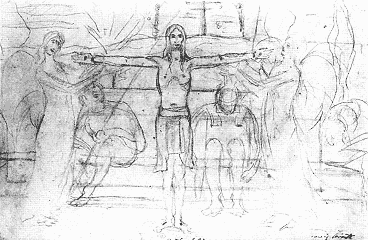
Figure 56
Lovis Corinth, Resurrection , 1896. Pencil, 30.6 × 46.5 cm.
Staatliche Museen, Berlin (DDR) (21/6292).
124), employ the same vertical, flower-strewn space, as does Nude Girl by the Water (B.-C. 142) of 1897, a painted version of the illustration Corinth had published in Jugend the previous year. Trifolium (1897; B.-C. 151) and Joy of Life (1898; B.-C. 153) are compositions based on a similarly flowing rhythm of the figures' gestural lines.
The portrait Corinth painted in 1897 of his friend Otto Eckmann (Fig. 57) is of special interest in this context, for here the stylistic features are also the specific attributes of the sitter. The uncial lettering of the inscription along the lower edge of the narrow canvas alludes to the studies Eckmann had begun in an effort to develop a typographic design in harmony with his Jugendstil borders and illustrations. Standing before a shallow ground, Eckmann holds a flower signifying his role as the creator and chief exponent of floral Jugendstil . The face is meticulously modeled, but the rest of the figure is simplified.
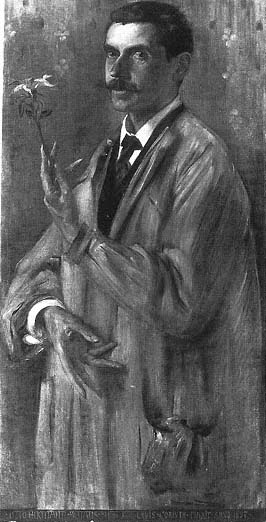
Figure 57
Lovis Corinth, Portrait of Otto Eckmann , 1897.
Oil on canvas, 110 × 55 cm, B.-C. 141.
Hamburger Kunsthalle, Hamburg.
Photo: Ralph Kleinhempel.
The ritualistic gesture of the attenuated hands adds a ceremonial touch to Eckmann's demeanor, an impression reinforced by the voluminous folds of the smock, so that the painter has the air of a celebrant of some new aesthetic creed.
The stylistic ambivalence of this and other paintings from the 1890s suggests that in pursuing the pictorial conventions of Jugendstil , Corinth simply undertook an exercise in a spirit of camaraderie—allowing himself to be "carried along in this stream," as he put it.[69] Apparently recognizing that he could not reconcile his own strong inclination toward naturalism with the
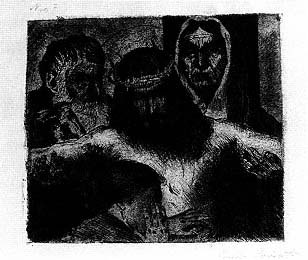
Figure 58
Lovis Corinth, Deposition , 1894. Etching,
13.0 × 14.5 cm, Schw. 9. Städtische Galerie
im Lenbachhaus, Munich (G4.515).
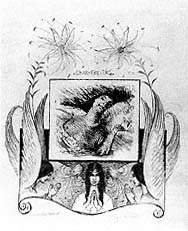
Figure 59
Lovis Corinth, Good Friday , 1894.
Lithograph, c. 32 × 28 cm, Schw. L8.
Orlando Cedrino, Munich.
decorative idiom of Eckmann and Strathmann, he abandoned his original intention to print the Deposition (Fig. 58) in a specially designed rectangular lithographic frame (Fig. 59). Instead, he printed the etching separately and subsequently used the lithographic frame for the image of a nude girl in bed, a substitution that implies a notable indifference on his part toward the religious motif. The ecstatic posture and expression of the model, copied from the painting of a full-length reclining nude of 1893 (B.-C. 109), strike a particularly odd note in conjunction with the inscription "Good Friday" just above the frame.
Return to the Successful "Meaningful" Theme
Despite his nonchalance about religious subjects, Corinth returned to the subject of the Deposition in 1895 and explored the multifigure composition of the etching on a more ambitious scale. Although the octagonal field of his large painting (Fig. 60) recalls similar framing devices by Carl Strathmann, he subordinated it to the composition so that neither the naturalistic execution nor the pathos of the conception is diminished. The figures in the foreground, reminiscent of the proletarian types in Fritz von Uhde's religious paintings, are life-size. The compressed space of the print has given way to a more ample grouping, with Christ at the center of a circle formed by the other figures. Mary occupies the same position as in the etching; Joseph of Arimathea helps to support the dead Christ and kisses a corner of the veil draped over Jesus' head; Nicodemus looks on; and John holds the shroud on which the body is laid. Christ's rigid limbs provide a grim counterpoint to the tormented embrace of the grieving Magdalene, now a sensuous nude with long, flowing hair, who presses close to him.
Corinth explained that in this painting he sought to emulate the tight pictorial structure of Mantegna's half-length figure compositions.[70] He also drew on several other sources that happened to be at hand. The anguished gesture of the Magdalene seems to have been derived from that of Rubens's Magdalene in Christ and the Penitent Sinners in the Alte Pinakothek, and Corinth's Deposition is related thematically and formally to Liberale da Verona's Entombment , also in Munich.[71] Liberale's linear style, like that of Mantegna and Botticelli, was popular in the 1890s, and the painting in the Alte Pinakothek was one of Corinth's favorites. Whenever he visited the museum, he made a point of seeing this picture first.[72] Years later, in his teaching manual, he reproduced a detail of Liberale's Entombment —cropped so that the figures are shown just down to the waist—to illustrate his discussion of facial expression and gesture.[73]
As with the painstakingly composed Pietà in 1890, Corinth's efforts were rewarded. The Deposition won a gold medal at the Munich Glass Palace in 1895 and was well received when shown at the international exhibition in Berlin the following year. A reviewer of the Berlin exhibition noted the truth and sincerity of the religious feeling he felt the painting expressed.[74] Corinth, however, seems to have maintained a casual attitude toward the subject, for in a caricature preserved in the Lenbachhaus, he transposed the painting into a ludicrous farce.[75] Self-irony may have led him to mock his own ambition in this way, especially since the Deposition turned out to be more than a fleeting
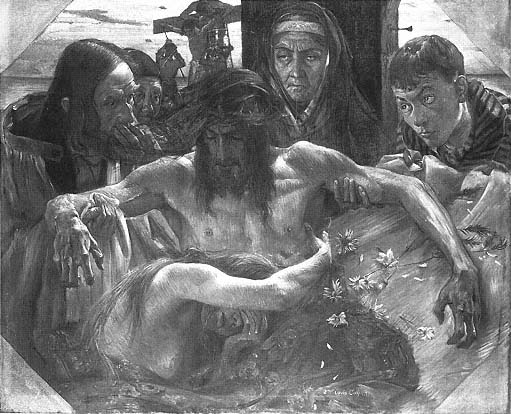
Figure 60
Lovis Corinth, Deposition , 1895. Oil on canvas, 95 × 120 cm, B.-C. 125.
Wallraf-Richartz-Museum, Cologne.
Photo: Rheinisches Bildarchiv.
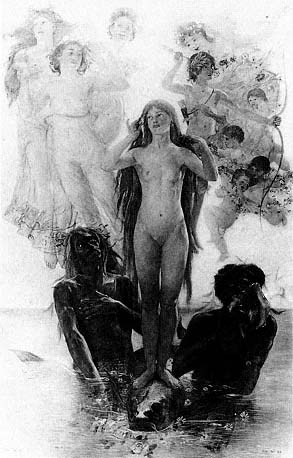
Figure 61
Lovis Corinth, Birth of Venus , 1896. Oil on canvas,
227 × 142 cm, B.-C. 132.
Present whereabouts unknown.
Photo: Bruckmann, Munich.
success. Soon after the painting was shown in Berlin, Corinth sold it to Martin Feuerstein for the substantial sum of 1,350 marks. Feuerstein was himself a painter of religious subjects and later taught this genre at the Munich Academy. With this sale Corinth, then thirty-eight years old, made money from his art for the first time. As he confided to Paul Eipper many years later, hence-forth he superstitiously made the purchase price of the Deposition the basis of all his price calculations, dividing or multiplying it as the occasion demanded.[76]
The success of the Deposition greatly strengthened Corinth's self-confidence. In 1896 he accepted his first student, Rudolf Sieger, and in quick succession completed three more ambitious multifigure compositions. As in the Deposition , he assured himself of the authority of tradition by drawing on several well-known earlier prototypes, which he updated in terms of more recent popular trends. The remote source of inspiration for the life-size Birth of Venus (Fig. 61) was no doubt Botticelli's famous painting in the Uffizi,
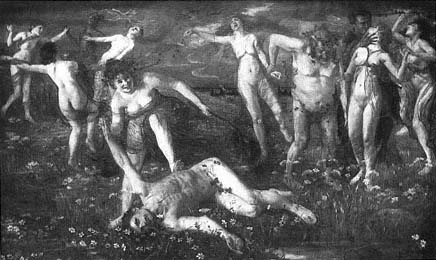
Figure 62
Lovis Corinth, Bacchanal , 1896. Oil on canvas, 118.7 × 201.0 cm, B.-C. 131.
Städtisches Museum Gelsenkirchen.
Photo: Dieter Grundmann.
modified by the memory of Bouguereau's composition of 1879 (Musée d'Orsay, Paris), which includes the Triton sounding a conch shell, the frolicking putti, and the cupid with bows and arrows. Some of the details are found in Böcklin's Magna Mater fresco of 1868 in Basel and the same painter's Venus Anadyomene of 1872–1873 (private collection), as is the expressive dolphin, to which Corinth added four adolescent female genii. Illuminated from both the right and the left and set off against a bright ground, the dark-skinned Tritons and especially the figure of Venus are carefully modeled, evidence of Corinth's continuing practice of preparing his figure compositions by drawing and painting directly from the nude.
The Birth of Venus remains well within the conventions of academic decorum, but in the Bacchanal (Fig. 62) Corinth's conception is so broadly comic that the painting parodies the sources that inspired it. The compositional format is dependent on Bouguereau's Education of Bacchus (1884; private collec-
tion), from which the two bacchants in the foreground have been taken with only minor modifications. Rubens's Drunken Silenus in the Alte Pinakothek provided the model for the group in the right half of the painting. The burlesque conception recalls similarly humorous mythologies by Böcklin as well as Corinth's own Tragicomedies . In a second bacchanal picture of 1896 (B.-C. 130) Corinth simplified the composition but further accentuated the bawdy humor of the procession. Silenus and his attendants are now the only important figures. They are seen from close up and are silhouetted against the sky, further emphasizing their coarse demeanor and ungainly appearance.
In the Sign of the Superman
The aggressive sensuality of Corinth's bacchanalia can be related to the Nietzschean theory of instinctual man,[77] which inspired belief in the supremacy of instinct over reason. This theory also lay behind Stuck's famous drawing of the mythological goat-god that appeared on the cover of the first issue of Pan in April 1895. Announcing the advent of a new man who will rise above bourgeois conventions, this issue also printed several excerpts from Nietzsche's Also Sprach Zarathustra . Since the original Pan circle—founded in 1892 in the Berlin café Zum schwarzen Ferkel—included both Otto Erich Hartleben and Walter Leistikow, Corinth may well have been aware of this belief in a restorative vitalism as early as 1893. He may also have known of the "classical" Fasching parties that Stefan George and Karl Wolfskehl staged in the early 1890s in Wolfskehl's Munich apartment. George would dress up as Julius Caesar or Dante, and Wolfskehl himself once appeared as Dionysus. Perhaps Corinth even met George, who is said to have had frequent contact in 1894 with Thomas Theodor Heine, Hermann Schlittgen, and Otto Eckmann.[78] Be that as it may, Corinth's bacchanalia are a far cry from George's and Wolfskehl's "almost pedantically pedagogic . . . demonstrations of the Nietzschean idea of creative inspiration through Bacchic ecstasy."[79] Like Stuck's equally drastic exaggerations, which elicited from Julius Meier-Graefe the observation that this painter" makes sphinxes out of waitresses and waitresses out of sphinxes,"[80] they belong to the less lofty ambience of the Munich Artists' Association's costume parties like the one organized for February 15, 1898, when under the motto "In Arcadia" the entire Bavarian court theater was transformed into the setting for a "classical carnival." For the stage Lenbach had designed a series of temple fronts behind which emerged the Athenian Acropolis. A statue of Dionysus standing inside a rose arbor occupied a prominent place in the fore-
ground, in conspicuous contrast with a replica of Phidias's Athena Promachos at the far back of the stage. The costumes, while intended to be archaeologically correct, looked comically out of date on the decidedly unclassical wearers.[81] Indeed, an account of the revelers' entrance parade into the theater captures just as fittingly the spirit of Corinth's paintings: "First there came bacchants and satyrs, a prankish lot, red-nosed and big-bellied old men with wine jugs and pouches, followed by cloven-footed, bleating fellows in goat skins. Slowly the procession dispersed . . . to the beer bar to imbibe nectar in a form the Isar-Athenian is most at home with."[82]
Also Nietzschean in inspiration is the unusual pencil and watercolor drawing It Is Your Destiny (Fig. 63), whose awkward title derives from the opening line of a poem Max Halbe dedicated to Corinth in 1895:
It is your destiny to wander the earth;
The good fortune of others is denied you.
Headlong you shall wander, seeking,
A restless guest at the richest table.
Whether you roam west or east,
You shall suffer the world's misery.
And though you wander north and south,
You will flourish nowhere.
You are condemned to search the earth;
The good fortune of others is denied you.
The peace of others gives you no rest.
You are a fugitive, a wanderer, a warrior.[83]
Halbe, who describes Corinth in his memoirs as an autodidact, alludes in the poem to what he believed to be Corinth's ultimate goal: the realization of his inner self.[84] The young knight in the drawing, dressed in shining armor, is indeed an idealized self-portrait. Flanked by a sensuous female holding a wineglass adorned with grape leaves and a shrouded old woman with a crown of thorns in one hand and a branch of laurel in the other, the armed hero—like Hercules at the crossroads—must choose between a life of ease and pleasure and the arduous path of virtue rewarded by fame. Naturally, like Hercules, the knight makes the right choice. By allowing his alter ego to reach for the crown of thorns, Corinth metaphorically drew a parallel between his struggle for fulfillment and the Passion of Christ, suggesting that he saw his search as his own via crucis —a notion encountered elsewhere in European
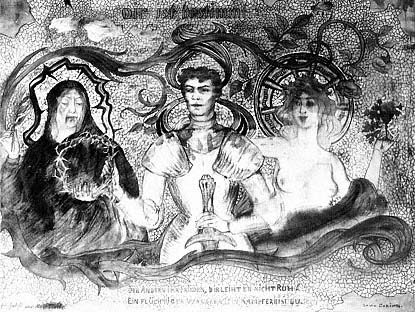
Figure 63
Lovis Corinth, It Is Your Destiny , c. 1895. Pencil and watercolor, 42.5 × 56.0 cm.
Städtische Galerie im Lenbachhaus, Munich.
painting at the turn of the century, most notably in the work of Gauguin, James Ensor, and Emile Bernard. By inscribing the opening words of Halbe's poem below the upper margin of the drawing and the two concluding lines along the bottom of the sheet, Corinth emphasized the warrior's unceasing, lonely struggle.
The idea of both the poem and the drawing can be traced to the contemporary fascination with the Übermensch , to borrow Nietzsche's term, whose virtues were especially those of the warrior and soldier. Indeed, the words of Halbe's poem echo the lofty tones of Zarathustra: "To you I do not recommend peace but conquest. Let your work be struggle. Let your peace be victory."[85] Corinth's own life-long esteem for Nietzsche apparently first developed in the circle of Max Halbe, for whom the philosopher was a favorite author.[86] As noted previously, Eckmann, Corinth's "spiritus rector," had also read Nietzsche, as had Hartleben and Wedekind. Any one of these men could have called Corinth's attention to the introductory studies on Nietzsche that
had been published in 1890 in Die Freie Bühne by the young Hungarian Joseph Diner, proclaiming Nietzsche the prophet of a new individualism. In a number of articles in Die Gegenwart and Kunstwart as well as in a widely read essay, Friedrich Nietzsche: Seine Persönlichkeit und sein System (Leipzig, 1890), Ola Hanson, the Swedish critic and novelist, further expounded Nietzsche's idea regarding the individual's right to personal fulfillment. The cult of the individual and the emphasis on personal success and achievement in German culture after 1871, combined with a yearning for a new primitivism and the liberation of human passions, also largely account for the success of Julius Langbehn's book Rembrandt als Erzieher , sixty thousand copies of which were printed at the time of its initial publication in 1890, followed by forty subsequent printings in the next two years alone.[87]
From a stylistic point of view, Corinth's Munich drawing is again highly eclectic. The dense mosaic-like background and the ornamental plant motifs derive from Strathmann and Eckmann, while the hieratic composition owes something to Jan Toorop's drawing The Three Brides (1893; Rijksmuseum Kröller-Müller, Otterloo), exhibited in 1893 at the Glass Palace in Munich and reproduced in October of that year in Die Kunst für Alle . Toorop, too, had made use of stylized forms for expressive and symbolic effects, contrasting forces of good and evil: in his drawing the celestial bride of Christ, holding a stalk of lilies, is on the left; the human virginal bride, surrounded by roses, is in the center; Satan's bride, whose attributes include a collar of skulls and a bowl of blood, stands on the right.
A Moment of Truth: Self-portrait with Skeleton
Unlike the idealized Jugendstil self-portrait in Figure 63, the Self-Portrait with Skeleton (see Plate 9), painted in 1896, shows Corinth without a mask and speaks of a different need for self-assessment. The painting is the first among his self-portraits in which he acknowledged the passage of time, noting his age alongside the signature and the year in the upper right. Although the day and month are not inscribed on the canvas, the painting may indeed have been the first in the long series of Corinth's "birthday pictures," self-portraits he was wont to paint on July 21 or as close to this date as possible. The painting documents Corinth's continued fascination with Böcklin's work, for it clearly derives from the Swiss artist's famous picture of 1872, now in Berlin. The fundamental conception, however, is entirely original, a naturalist's answer to Böcklin's self-conscious posturing. In Böcklin's self-portrait, which also
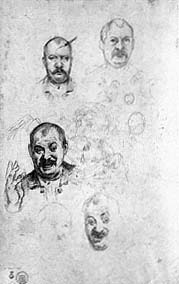
Figure 64
Lovis Corinth, Self-Portrait
Sketches , c. 1896. Pencil,
47.2 × 30.0 cm. Staatliche
Kunstsammlungen Dresden,
Kuperstich-Kabinett.
prompted Hans Thoma's similarly romantic Self-Portrait with Death (1875; Staatliche Kunsthalle, Karlsruhe), the painter, palette and paintbrush in hand, listens to Death as if to an inspiring muse; Death, playing the fiddle, is shown as a "living" counterpart to the painter, whereas in Corinth's picture the specter has been reduced to a studio prop. Instead of Böcklin's evocative chiaroscuro, bright daylight enters the studio through the large window, beyond which lies the suburban landscape of Schwabing, with church steeples and smoking chimneys in the distance. While the skeleton functions as a conventional memento mori , Corinth's own likeness is recorded with such honesty that it is itself an image of transcience. The painter's corpulence belies his age, thirty-eight; the face is bloated; the eyes are dulled from years of excessive drinking. An even more incisive description of physical deterioration is communicated by the self-portrait sketch in the upper left of a sheet of studies preserved in Dresden (Fig. 64). These drawings date from about the same time as the Munich painting and conveniently juxtapose Corinth's stylistic experiments of these years. The stylized self-portrait in the upper right is reflective, but the expression remains subordinate to the idiosyncratic draftsmanship. In the two lower sketches—to the left and below the faint outlines of a caricature of Otto Eckmann—Corinth mimed what he felt or thought he felt, resorting to exaggeration. Only in the upper left sketch did he confront his image with searing objectivity.
A Painter of Saints and Whores
Following his break with the Munich Secession, Corinth exhibited only literary or related symbolic subjects at the Munich Glass Palace, apparently because he continued to believe that the key to public acclaim lay in the "meaningful" theme. With the Crucifixion (Fig. 65) of 1897 he turned his attention to the most central image of Christian iconography, hallowed by a long tradition in Western art. The extent to which he subordinated himself to that tradition is readily seen when the painting is compared with Max Klinger's selfconsciously novel interpretation of the same subject (Fig. 66). Corinth surely knew Klinger's composition, for the painting was exhibited in 1893 at the Glass Palace in Munich, where the uncompromisingly naked Christ caused such an uproar in ecclesiastical circles that the figure had to be covered from the waist down with a piece of cloth. Corinth's conception, by comparison, remains safely within the conventions of the late medieval Andachtsbild , although the stylistic handling is as unflinchingly naturalistic as Max Klinger's. The composition closely follows Jordaens's altarpiece in St. Paul's Church in Antwerp, a picture Corinth knew from his sojourn in the Belgian city. Although the two thieves are not included in Jordaens's painting, Corinth derived from that work not only the general distribution of the figures but also some of the details. Within the shallow space the figures are arranged parallel to the picture plane, with John and the Virgin to the left of the cross and the Magdalene and another holy woman to the right. The mourners' gestures and glances achieve a maximum of empathy, keeping the viewer's attention focused on the figure of Christ. When the painting was exhibited at the Munich Glass Palace in 1898, critical attention happened to center on yet another recent picture by Klinger, the monumental Christ on Olympus (1897; Museum der bildenden Künste, Leipzig), an ambitious allegory of the victory of Christianity over the gods of ancient Greece. Corinth, who noted somewhat enviously the fuss being made about Klinger's picture,[88] exhibited the Crucifixion the following year in Dresden and at Eduard Schulte's gallery in Berlin. Soon afterward the picture was purchased by the Munich manufacturer Ernst Heckert,[89] who subsequently gave it to the Protestant Church in the Bavarian town of Bad Tölz, where the work was installed by November 1901. Although this was the kind of success Corinth had least expected, he was especially proud of it.[90]
During these years Corinth, most likely under the banner of Nietzsche's instinctual man, repeatedly turned his attention to the theme of men's physical dominance over women. In 1894 he depicted the subject three times, in
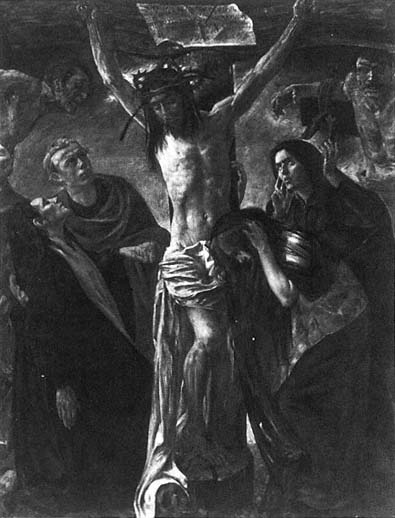
Figure 65
Lovis Corinth, Crucifixion , 1897. Oil on canvas, 229 × 176 cm, B.-C. 138.
Evangelische Kirche, Bad Tölz.
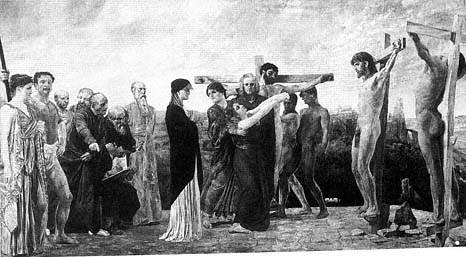
Figure 66
Max Klinger, Crucifixion , 1890. Oil on canvas, 251 × 465 cm.
Museum der bildenden Künste Leipzig (1117).
Rape of the Sabine Women , as in the drawing in Berlin already mentioned in connection with Tragicomedies (see p. 83), and in two etchings, Rape (Schw. 6) and Abduction (Schw. 7). In 1895 he made a color lithograph Rape of Woman (Schw. L13) and the same year repeated the composition in a bronze relief.[91] Related to these various "rapes" is Susanna and the Elders (Fig. 67) of 1897, which places the theme in an Old Testament setting. Like Corinth's earlier version of the subject (see Fig. 34), the painting was derived from a well-known prototype. This time it was Anthony Van Dyck's painting in the Alte Pinakothek that provided the pose and gestures of the voluptuous heroine. The burlesque conception departs notably from the predominantly academic concerns governing the Susanna in Essen and reflects both the influence of Böcklin and the tone of Corinth's own recent Tragicomedies .
In an independent sketch of the same subject done in 1898 (Fig. 68), Corinth freed himself from his prototype to explore the content in a more purely pictorial manner. The forced physiognomic expressions are now subdued and the lines themselves organized so as to create a dynamic equilibrium of movement and countermovement—a pictorial equivalent, in short, of the conflict that in the painting is no more than a parody. The drawing lacks detail without sacrificing meaning. Suggestion rather than description invests the sketch with the expressive strength that eventually was to distinguish Corinth's mature works.
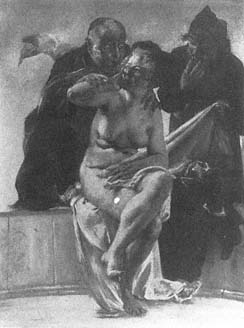
Figure 67
Lovis Corinth, Susanna and the Elders , 1897.
Oil on canvas, 98 × 74 cm, B.-C. 144.
Present whereabouts unknown.
Photo: after Bruckmann.
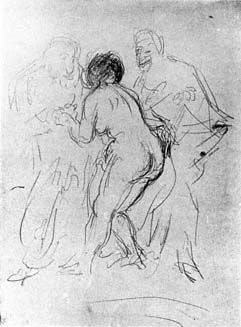
Figure 68
Lovis Corinth, Susanna and the Elders , 1898.
Pencil, c. 44.0 × 34.5 cm. In auction at
Karl und Faber, Munich, 1974;
present whereabouts unknown.
Photo: after Kuhn.
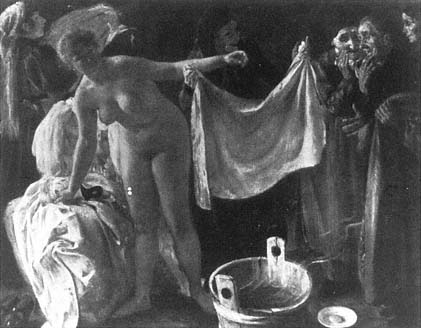
Figure 69
Lovis Corinth, Witches , 1897. Oil on canvas, 94 × 120 cm, B.-C. 145.
Present whereabouts unknown.
Photo: after Bruckmann.
The Nietzschean cult of vitalism rampant in Munich in the 1890s seems to have had a liberating effect on Corinth, for his themes of conflict between man and woman mark the onset of a steamy sensuality that was to inform his works with growing frequency, particularly his depictions of the female nude. Having drawn and painted the nude for years as if it were but another form of still life, he now began to see woman both as the catalyst for man's passion and as a being capable herself of strong physical sensations. The voluptuous nude in Witches (Fig. 69) is fully conscious of her charm. Her bath completed, she prepares to dress for a costume ball while several old women looking on
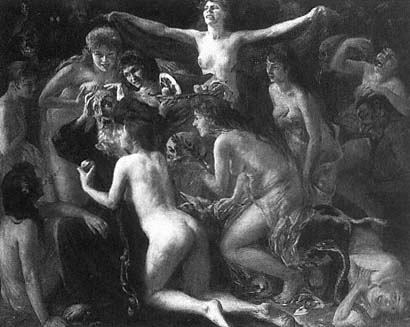
Figure 70
Lovis Corinth, The Temptation of Saint Anthony , 1897. Oil on
canvas, 88 × 107 cm, B.-C. 149. Museum Ostdeutsche Galerie Regensburg.
cackle suggestively. In the Temptation of Saint Anthony (Fig. 70) the devil and the three nudes from the same episode in Tragicomedies (see Fig. 44) are surrounded by a considerable following, and the hermit saint finds himself not merely tempted but set upon by seductive females. Gone is the blasphemous allusion to the crucifix. Instead, the central nude spreads her arms to raise her long strands of hair as if about to descend on the saint like a bird of prey. Some of the nudes offer gifts; others seek to arouse the saint's desire or to satisfy their own. Devils and human skeletons in the background increase both the pictorial congestion and the saint's despair. Corinth's painting of the Crucifixion, Witches, Temptation of Saint Anthony and Susanna and the Elders all in the same year, and seemingly in random order, suggests something of his casual attitude toward any one theme. Although it is impossible to be specific, these pictures evidently created some notoriety, as is suggested by a short story à clef by Joseph Ruederer, in which one of the characters asks Corinth whether he was painting only saints and whores.[92]
A Butcher's Store and Plein Air Portraits
The extensive iconographic range of Corinth's works from the 1890s is a constant source of frustration to anyone seeking to bring order to the painter's varied output. Indeed, in 1897 he achieved a new level of competence in subjects that had claimed his attention previously: the light-filled interior and the portrait in the open air. In the butcher's store interior (Fig. 71), painted in the small town of Schäftlarn in the Isar Valley, he subordinated the visceral conception of the slaughterhouse scene from 1892 (see Plate 6) to a more controlled structural logic in keeping with the less aggressive character of the subject. The vaults of the setting divide the pictorial field vertically into equal halves; the resulting equilibrium is subtly modified by the scaffolding of the meat racks. The simple ground, painted in relatively unified shades of red and green, provides an effective foil for the multicolored cuts of meat displayed on the counter and suspended from hooks above it. They derive their gleaming texture from the fatty gloss of the paint itself, applied in deft strokes of red and pink shot through with specks of white and purple. Unlike the butcher's store interior that Max Liebermann painted in 1877 in the Dutch town of Dordrecht (Kunstmuseum, Bern), Corinth's painting has an expressive anecdotal content that ultimately allies it to the small slaughterhouse scene of 1892. The butcher's apprentice provokes the viewer's sensibilities by presenting a large dish piled high with pieces of freshly cut meat, his expression of smug self-satisfaction a mocking reminder of the grisly process just completed.
In the portrait of Berta Heck (Fig. 72), the sister of Max Halbe's wife, Corinth achieved a similar unity of structural logic and expressive content. The motif of the young woman seated in a boat, with a male companion just visible behind her, recalls similar paintings by the French Impressionists, in particular Manet's Boating (1874; Metropolitan Museum of Art), although it is impossible to say whether Corinth at this point actually knew these pictures. Having set up his canvas at the back of the boat, he apparently executed the painting from start to finish out of doors. But in contrast to the psychologically neutral approach of painters like Manet and Monet, Corinth was clearly unwilling to sacrifice the facial features of the model to the evanescent, form-dissolving effects of light. The brushstrokes, applied broadly to the lake and the distant shoreline and rapidly in the blouse and hat, become more differentiated in the young woman's face, making it both the structural and psychological focus of the composition. Averting her gaze, Berta Heck is absorbed in her innermost thoughts. The simple pictorial structure, dominated by three broad horizontal bands that divide the background, reinforces the picture's
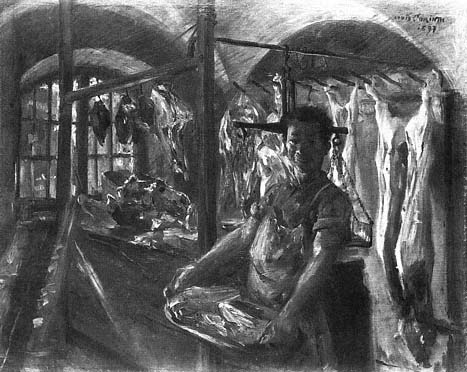
Figure 71
Lovis Corinth, Butcher's Store at Schäftlarn , 1897. Oil on canvas, 69 × 87 cm, B.-C. 147.
Kunsthalle Bremen.
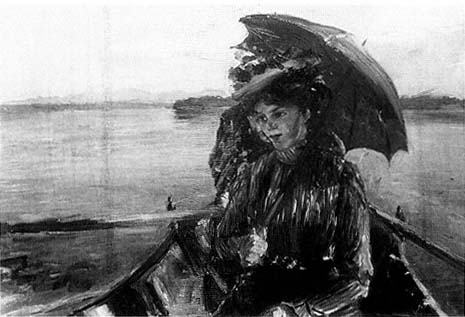
Figure 72
Lovis Corinth, Berta Heck in a Boat , 1897. Oil on canvas, 57 × 84 cm,
B.-C. 140. Dr. Karl Schmidt, Cologne.
Photo: Marburg/Art Resource, New York.
mood of quiet reverie. This sentiment is the result not only of considerable artistic growth but presumably also of a harmony between painter and model that prompted Corinth's empathy, allowing him to rise above a mere description of the sitter.
In a similar way only considerable mutual trust can have made possible a portrait such as the one Corinth painted of Bertha Heck's sister, Luise Halbe, the following year (Fig. 73). Corinth actually painted two portraits of Max Halbe's wife at this time. The other, a life-size three-quarter-length portrait showing her standing in a garden (B.-C. 161), is more formal in conception, underscores her fashionable appearance, and, as a result, remains psychologically detached. The small panel in Munich, by comparison, is an unassuming and personal work, whose closely circumscribed pictorial field emphasizes the woman's open gaze. The extreme close-up view virtually forces the observer to share in the intimate dialogue between painter and model. Painted in August 1898 in the village of Ammerland, on the eastern shore of the Starnberger See where Max Halbe and his family were spending the summer, the picture is a plein air portrait by implication only, for its sunny air is entirely a
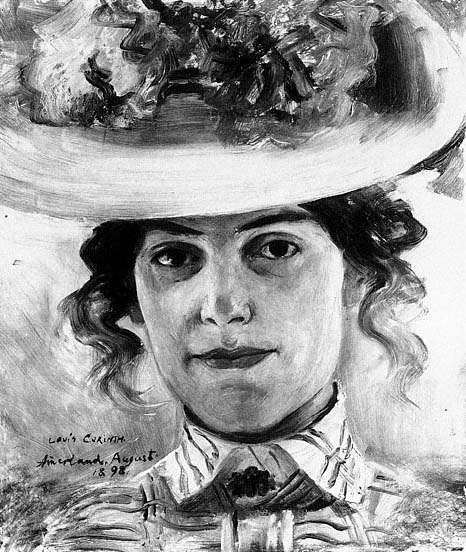
Figure 73
Lovis Corinth, Portrait of Luise Halbe in a Straw Hat , 1898. Oil on wood, 35 × 30 cm,
B.-C. 160. Städtische Galerie im Lenbachhaus, Munich (G 13.004).
function of the three primaries red, yellow, and blue. As in the portrait of Berta Heck, the brushstrokes have been applied freely only on the periphery of the composition while the face itself is carefully modeled.
Corinth's charming plein air group portrait (see Plate 10), painted in August 1899 in Bernried on the Starnberger See, also originated in the congenial company of Max Halbe's family. Facing the viewer, the playwright sits in a garden, his wife to his left and Berta Heck to his right. The bearded fellow wearing the traditional Bavarian suit and hat is the Viennese writer of comedies Carl Rössler. Like the portrait of Benno Becker and the double portrait of Langhammer and Brand (see Plate 5, Fig. 37), the painting has the character of a genre scene. Max Halbe, with a touch of amusement, looks up from the newspaper as his wife offers Carl Rössler a peach. Berta Heck, about to sip from her cup, smiles at the tempting offer. According to Halbe, the painting was completed in the course of a few morning hours;[93] and there is no reason to doubt that this is so, even though Corinth inscribed the canvas with the dates August 28–31, 1899. Perhaps the inscription refers to the duration of the painter's visit, Rössler's, or both. It is also possible that the picture was painted in several brief morning sittings on the dates inscribed. As in the plein air portraits of Berta Heck and Luise Halbe, the vigorous brushstrokes serve a tightly controlled modeling only in the faces. Despite the seeming spontaneity of the overall execution, it is evident that the composition was carefully planned and nuanced so as to emphasize Corinth's hosts. The women are related on a diagonal axis that intersects a corresponding one for the men, and these structural lines are reinforced by the shades of white that link Luise Halbe and Berta Heck and the darker tones of the men's clothing. Max Halbe and his wife have been given special prominence, he by his frontal position next to the tree trunk that divides the composition in the center and she by her placement in the right foreground and by her action, which provokes the gestures and glances of the other three. Indeed, Luise Halbe is the psychological center of the composition, and the painting itself is a testimony to her charm and the unpretentious hospitality that made the Halbes' home so appealing.
Firm in Loyalty
A far more dispassionate conception governs the ambitious group portrait of twelve members of the Munich Freemason Johannes Lodge (Fig. 74), despite the work's painterly qualities. According to the inscription in the upper right,
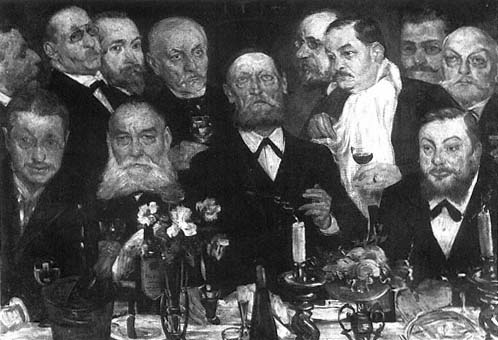
Figure 74
Lovis Corinth, Firm in Loyalty , 1898–1899. Oil on canvas, 113.0 × 162.5 cm, B.-C. 164.
Städtische Galerie im Lenbachhaus, Munich.
Corinth first worked on the painting in April and May of 1898 but did not complete it until May and June the following year. A preliminary watercolor drawing in the Lenbachhaus bears the date 1897 and anticipates the final composition closely, except that it includes only nine members of the lodge. With the possible exception of the portrait of Carl von Gayling (B.-C. 106) of 1893, this painting may have been Corinth's earliest commission. Apparently he had painted his previous portraits on his own initiative; all depict either relatives or friends. Corinth may have received the commission because of his own affiliation with the lodge. A member of the Königsberg Immanuel Lodge since 1890, he had been a co-founder of the Munich lodge in 1896 and retained membership in that organization for the rest of his life, holding the office of master of ceremonies.[94] The twelve men, stalwart representatives of various professions,[95] are closely grouped behind a table laden with glasses,
bottles, and bouquets of flowers. Two candles, no doubt symbolizing two of the three Masonic virtues (wisdom, strength, beauty) have just been extinguished as the master of the lodge, seated in the center, prepares to propose a solemn toast. In the empty space just above his head the initial letters of the lodge's motto, "i[n] T[reue] f[est]" ("firm in loyalty") appear, flanked by two talismanic symbols, a square and interlacing triangles that form the six-pointed star of Solomon's seal. Although Corinth sought to utilize the moment of the collective toast to unify the group, he did not succeed in integrating the twelve individuals psychologically. Only three of the men are absorbed in the proceeding; for the others, participation is perfunctory. It is doubtful that Corinth intended to caricature the collective spirit of this and, by implication, other social institutions of the kind.[96] The scattered psychological energy of the painting can be explained by the extended working process and the assembly of the group portrait from individual portrait studies. Even such masters of this type of painting as Frans Hals and Rembrandt could not always avoid the pitfalls of this working method. The forced physiognomic expressions are simply another result of Corinth's efforts to give the group dramatic cohesion. Late in his life Corinth proudly and fondly remembered the painting as a "Doelenstück," in allusion to the doelen , or guards' hall, of seventeenth-century Holland and Dutch group portraits of shooting companies and civic guards.[97] The dazzling manner in which the still-life elements have been painted is indeed worthy of Frans Hals, although the general disposition of the figures—the tight-knit grouping of the heads in two rows—was derived from another source, perhaps one of the late sixteenth-century corporation portraits by Dirk Jacobsz. Often in Dutch group portraits of this type the place above the central figure contains the crest of the guild or a tablet with the names of the persons represented, a device similar to the initial letters of the lodge's motto in Corinth's painting.[98]
New Ferment: The Berlin Secession
Between the beginning and the completion of the group portrait of the Johannes Lodge lay events that were to be of great consequence for Corinth's career. In December 1898 he traveled to Berlin, where several of his paintings, including the Crucifixion (see Fig. 65), were exhibited at the gallery of Eduard Schulte. While in Berlin, he received news that a Leipzig physician, Dr. A. Ulrich, was going to purchase the Temptation of Saint Anthony . Still more encouraging was the artistic climate then developing in Berlin under the ener-
getic leadership of Corinth's old friend Walter Leistikow. Since 1892 Leistikow and Max Liebermann had headed the Gruppe der Elf (The Eleven), an informal organization created to provide a forum for modern art through small exhibitions independent of the large shows at the Glass Palace sponsored by the Berlin Artists' Association. Without breaking with the association, the Eleven held their first show on April 3, 1892, at the gallery of Eduard Schulte and continued to exhibit there regularly each spring until 1897.
Meanwhile, the Berlin Artists' Association itself was beginning to stir with a more enterprising spirit. As part of an effort to introduce foreign artists to Berlin, the association decided to invite the Norwegian painter Edvard Munch to mount a major show of his works at the Architektenhaus. The Munch exhibition of fifty-five paintings and oil sketches, including the original version of Puberty (1886; destroyed), had hardly opened on November 5, 1892, when Anton von Werner and the Berlin Academy protested. "Formlessness" and "base sensibility" were two of the kinder epithets hurled at Munch by the conservative press.[99] The controversy assumed such proportions that the exhibition closed on November 12. But by November 20 Munch's paintings were being shown at branches of Eduard Schulte's gallery in Düsseldorf and Cologne, and in December they were again on exhibition in Berlin, at the Equitable Palace, this time without any incident. But the affair had dealt a severe blow to the fragile relationship between the Berlin Artists' Association and the Eleven, who had vigorously defended the Norwegian painter's right to exhibit. An uneasy truce ensued until 1898, when the Glass Palace jury's rejection of one of Leistikow's Grunewald landscapes (see Fig. 40) brought about a final rift, precipitating the founding of the Berlin Secession in May of that year.
Liebermann accepted the presidency of the fledgling organization, but Leistikow, who held the office of first secretary, was its driving force. He and his fellow Secessionists saw as their first task the organization of an exhibition that could compete successfully with the next show at the Glass Palace, scheduled to open in May 1899. Fearing that the Secession was not yet ready to stand on its own, they sought additional support by promising exhibition space to artists from other cities in a gallery still to be found. When their efforts to rent suitable exhibition space failed, they decided to build a gallery, raising money from members and wealthy patrons. Many of the contributors were from prominent Jewish families, the mainstay of Berlin's cultural life in the ensuing decades. Among these early patrons of the Berlin Secession were Richard Israel, the owner of the Berlin department store, who promptly bought Leistikow's rejected Grunewald landscape and donated it to the National Gallery; the bankers Julius Stern and Carl Fürstenberg; and cultured industrialists like the young Walther Rathenau.[100]
It was only to be expected that Leistikow would recruit Corinth as yet another supporter of the Secessionist cause. Hoping that lucrative portrait commissions might induce Corinth to settle in Berlin, Leistikow sought to introduce him to prominent members of society. But the pastel portrait Corinth painted in late December 1898 of Leistikow's student Gertrud Sabersky (Collection Lucie Mainzer, Innsbruck) was unfortunately the only commission he obtained. As a result Corinth returned to Munich about the middle of January 1899.
Meanwhile, the Berlin Secession had acquired rights to the land next to the Theater des Westens on Kantstrasse, suitable for the construction of their own building. Two cousins, Bruno and Paul Cassirer, partners in a recently opened gallery and publishing firm, agreed to manage the Secession's business affairs. In return for their services the Secession granted them privileges far beyond the customary sales commission of five percent: they held membership on the executive committee, with an advisory vote, and participated in selecting and installing works for exhibition.
The first exhibition of the Berlin Secession opened on May 20, 1899, in a quaint stucco structure made up of a short, squat tower, set aside for administrative offices, and six adjoining gallery rooms. About three hundred works were shown, a marked improvement over the mammoth spectacles at the Berlin Glass Palace. Although the exhibition was devoted mostly to German art, the open-mindedness pledged by Liebermann in his preface to the catalogue was evident in the range of painters represented.[101] They included members of the Worpswede colony, such as Fritz Mackensen, Otto Modersohn, and Hans am Ende; realists like Menzel, Leibl, and Trübner; and such exponents of late nineteenth-century idealism as Böcklin and Stuck. Ferdinand Holder's painting The Dispirited (1892; Staatliche Gemäldesammlungen, Neue Pinakothek, Munich) introduced the Swiss artist for the first time to a large number of his Berlin colleagues. Max Slevogt sent his ambitious triptych The Prodigal Son (1898-99; Staatsgalerie, Stuttgart), and Corinth exhibited two paintings, Returning Bacchants (1898; B.-C. 154), a variation on his bacchanal of 1896 (see Fig. 62), and a more recent work, Demon (1899; B.-C. 173), a provocative three-quarter-length femme fatale . Diversity in style and conception, as epitomized by the works in this first exhibition, remained a guiding principle of the Secession throughout its existence.
Berlin Beckons Anew
On October 16, 1899, Corinth returned to Berlin, stopping in Leipzig for a brief visit with Dr. Ulrich, who had purchased two more paintings. In addi-
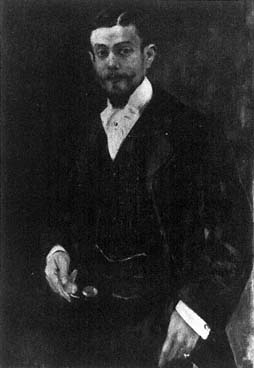
Figure 75
Lovis Corinth, Portrait of Richard Israel , 1899.
Oil on canvas, 100 × 68 cm, B.-C. 190.
Present whereabouts unknown.
Photo: after Bruckmann.
tion to the Temptation of Saint Anthony , the physician now also owned Witches and the Self-Portrait with Skeleton . Corinth went to Berlin this time to oversee the hanging of his paintings for a one-man show at the gallery Reiner and Keller. It opened on October 20 and was well received. In December he participated in an exhibition of German realist painting at the gallery of Bruno and Paul Cassirer. It was most likely Leistikow who had paved the way for this introduction of Corinth's work on a larger scale in Berlin. Corinth, in turn, took the exhibitions as an excuse for an extended stay, an attractive prospect since Berlin was now beckoning in other ways. The portrait commissions that Leistikow had tried to obtain for him the previous winter finally began to materialize, promising sound financial support should he decide to settle permanently in the capital. That he was contemplating such a move is evident from a letter dated December 28, 1899, to Joseph Ruederer, in which Corinth acknowledged his gratitude to Leistikow and also spoke of the congenial relationship developing between him and Max Liebermann.[102] Otto
Eckmann, too, who since 1897 had taught at the Berlin School of Arts and Crafts, did his utmost to make Corinth feel at home. He offered him the best wine from his cellar and asked his wife to prepare Corinth's favorite East Prussian dishes.
The commissioned portraits Corinth painted in the fall of 1899 include that of the gynecologist Dr. Ferdinand Mainzer (B.-C. 187), who had recently married Leistikow's former student Gertrud Sabersky; that of Richard Israel (Fig. 75), Leistikow's benefactor and a generous supporter of the Berlin Secession; and that of Israel's father-in-law, Emil Cohn (B.-C. 183), who owned two Berlin newspapers, the Volkszeitung and the Berliner Tageblatt . In these works, in contrast to the intimate format he usually chose for the portraits of his friends, Corinth adopted a larger canvas, showing the figures in half and three-quarter length before a neutral ground. There is generally also greater emphasis on the modeling of the individual forms. Verisimilitude and allusion to the sitter's accomplishments were expected in these portraits, and Corinth dutifully delivered psychologically neutral but faithful depictions of the successful physician, merchant, and publisher. At this time Corinth also began a full-length portrait of Israel's wife, Bianca, dressed in an elegant white gown. Dissatisfied with the picture, however, he destroyed it before it was finished.
An interesting and much more personal conception prevails in the portrait of Frau Rosenhagen (Fig. 76), the mother of the Berlin critic Hans Rosenhagen, who was Leistikow's friend and one of the first outspoken defenders of the Berlin Secession. The painting was a labor of love. Corinth knew the sitter well from his previous visit to Berlin and other encounters in Munich, where Rosenhagen and his mother usually stopped each year on their way to their summer retreat. With this painting Corinth returned to a portrait formula that had last occupied him in 1892 (see Plate 5), except that now light also assumes an expressive rather than merely a descriptive function, reinforcing the sitter's dominance over the interior she occupies. Corinth painted Muttchen Rosenhagen, as friends called her, sometime in November—and in the course of a little more than five hours—in the small Berlin apartment she shared with her son.[103] Corinth neither diminished the ravages of old age nor disguised the dour mien of a sitter well known for her cantankerous spirit. The high forehead is exposed, the thinning hair fluffed up above the ears. The cheeks are sunken, the narrow lips firmly closed, the dim eyes surrounded by red circles. Everything about the sitter speaks of resolute composure and of an unmistakable will to control both herself and others. This psychological projection gives meaning to the light that pervades the painting. The light, strongest in the flesh parts, is absorbed by the plush upholstery of the couch and the reddish brown tones of the dress but flickers up again in the pillow
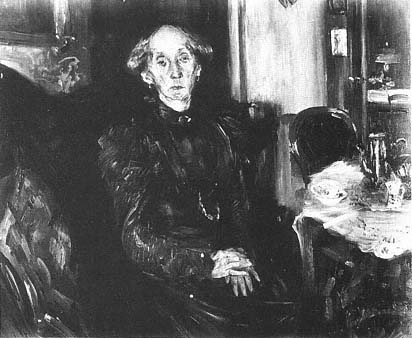
Figure 76
Lovis Corinth, Portrait of Mother Rosenhagen , 1899. Oil on canvas,
63 × 78 cm, B.-C. 182. Staatliche Museen Preussischer Kulturbesitz,
Nationalgalerie, Berlin (West) (A II 984).
Photo: Jörg P. Anders.
and the sleeve, in the brooch, and in the long chain of the gold necklace. From there it gradually invades the rest of the interior, from the sparkling coffee still life and the gleaming furniture and picture frames to the lamp on the table in the adjacent room.[104]
A similar intuitive grasp of the interrelation of content and form is seen in the painting of a reclining female nude (see Plate 11), also painted in Berlin. Here Corinth's depiction of the female body, for so long the subject of formal analysis, has undergone a profound change. Indeed, he had never before captured the erotic allure of the female with such conviction. The ecstatic posture of the model is far removed from the conventional studio pose. She writhes provocatively on disheveled sheets, her voluptuous body set off against the white bedding; the mass of dark hair and the black stockings fur-
ther accentuate the warm skin tones. The broad brushstrokes are in part so independent of any descriptive function that they translate the image into a pictorial metaphor for rapture. Corinth most likely painted the picture in the quarters he had rented during his stay in Berlin at Körnerstrasse 26, and it must have been a rare felicitous moment indeed that allowed him to abandon himself to his own sensual experience and thus to transcend the coy suggestiveness and forced eroticism of his earlier nudes from the 1890s, such as the one he had adapted to his irreverent print Good Friday (see Fig. 59). That Corinth painted the picture rapidly and without much premeditation is suggested by the remains of an old signature still visible about halfway up the center of the canvas. Intoxicated by the image before him and seeking to capture the experience quickly, he apparently reached for one of his finished pictures and painted the nude right over it.
Exactly when Corinth began work on the remarkable painting of Salome (see Plate 12) is not known. The preliminary oil sketch (B.-C. 170), now in the Busch-Reisinger Museum, is undated; the finished version is inscribed with the year 1900. Corinth may have begun the painting before his journey to Berlin, completing it after his return to Munich in early January 1900.[105] Disregarding traditional conventions, he transposed the familiar subject into a milieu that is not only outrageously modern but also downright commonplace. The makeshift robes and vulgar figure types give the scene the character of a tableau vivant staged by studio models at a costume ball. This impression is reinforced by the nonchalant detachment with which the gruesome episode is reenacted. The executioner, still holding the bloody sword, watches with satisfaction as the headless body of the Baptist is carried away. Herod's daughter, arriving as if by chance with her female companions at the site of the beheading, examines the head of Saint John, leaning forward for a better look, her voluptuous breasts almost touching the Baptist's beard. With unruffled curiosity, she daintily pries open one of the saint's eyes, as if to force him to acknowledge her beauty, if only in death. The eight life-size figures, some partly hidden, are grouped in the foreground in a tight-knit composition that is cut on all sides, a device that further intensifies the immediacy of the portrayal. It is as if the viewer too had happened on the scene.
Salome belongs to the general theme of sexual conflict discussed earlier in relation to Corinth's output from Munich. A favorite paradigm of sadistic love in both painting and sculpture by the 1880s,[106] the subject became even more popular after the publication of Oscar Wilde's play in 1893. Yet Corinth apparently did not get to know Wilde's play until 1902, when it was first performed in German translation in Berlin. His Salome, moreover, unlike Wilde's de-
praved vampire, is capricious rather than possessed by evil desires—more like a character from an Offenbach operetta and similar in spirit to the caricature of Salome that Jules Laforgue published in La Vogue in the summer of 1886 in one of his Moralités légendaires .[107]
Soon after completing the Salome , Corinth applied for the necessary papers to submit the painting to the upcoming exhibition of the Munich Secession. He had not exhibited with the group since 1893 and perhaps assumed that his growing reputation in Berlin had mollified those who still remembered his role in the "plot" of the Free Association and that he would be welcomed back into the cultural life of the city. But when the executive board of the Munich Secession rejected his application, he discovered that the old grievances were still very much alive. Walter Leistikow, on a visit to Munich, praised the Salome highly and told Corinth to send it to the next exhibition of the Berlin Secession instead, assuring him that it would be enthusiastically received.
This episode taught Corinth that Munich was unlikely to offer him the professional satisfaction and financial success he had begun to enjoy in Berlin. Thus he was happy to accept an invitation from Richard and Bianca Israel to join them at their country estate at Schulzendorf, not far from Berlin, for an extended period of work and relaxation. There, between the end of May and the end of June 1900, Corinth painted three portraits: a full-length portrait of Bianca Israel in formal evening attire (B.-C. 175), clearly a substitute for the abortive painting of the previous winter;[108] a more personal and intimate picture of Bianca Israel seated in the garden (B.-C. 191); and a group portrait of the four Israel children (B.-C. 195). In July the Salome was included in the second exhibition of the Berlin Secession and, as Leistikow had predicted, turned out to be a sensational success. "The painting has been executed with great technical, almost academic bravura," wrote Hans Rosenhagen in his review of the exhibition in Die Kunst . "One gets the impression of a certain perversity. . . . Among all of Corinth's paintings this Salome is surely the most original and interesting."[109] The painting, reproduced as a full-page illustration accompanying Rosenhagen's review, solidified Corinth's reputation as one of the most compelling figure painters of his time.
Following a trip with Leistikow through Denmark, Corinth returned briefly to Munich in early August, but by September he was back in Berlin, where he took a temporary atelier at Lützowstrasse 82, where both Leistikow and Edvard Munch had earlier maintained studios. His circle of friends was considerably enlarged when he joined the Freundschafts- und Rosenbund that Leistikow had founded in honor of Gerhart Hauptmann. Among the group's regular members—besides Leistikow and Hauptmann himself—were Ludwig
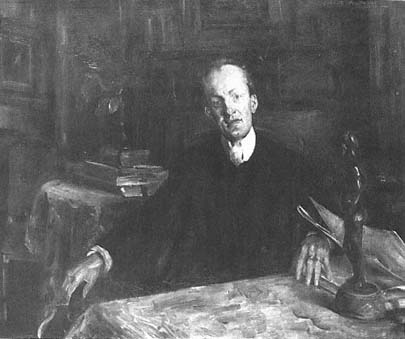
Figure 77
Lovis Corinth, Portrait of Gerhart Hauptmann , 1900. Oil on canvas,
88 × 107 cm, B.-C. 202. Städtische Kunsthalle Mannheim.
von Hofmann and the Norwegian painter Bernt Grönvold; depending on the occasion, this contingent was augmented by various guests. The statutes governing the group were simple: each member took his turn inviting the others for dinner; champagne was the official drink. It must have been an odd sight indeed to watch the initiates take their seats around a table adorned with roses, for each member also wore a rose garland on his head. One of the more memorable dinners was the one Gerhart Hauptmann gave in December 1900 at the Palast Hotel after the dress rehearsal of his drama Michael Kramer : the regulars were joined by Otto Brahm, director of the Deutsches Theater; the actors Rudolf Rittner and Max Reinhardt, both of whom were then still members of Brahm's ensemble; and Hauptmann's publisher, Samuel Fischer.
The portrait Corinth painted of Gerhart Hauptmann (Fig. 77) in October 1900 depicts the playwright in the privacy of his study at his home in Berlin-
Grunewald. Hauptmann (1862–1946), not yet thirty-seven years old, was at the height of his career, having attained a reputation as one of the chief exponents of modern drama. His plays include Vor Sonnenaufgang (1889), a drama that inaugurated the realist movement on the modern German stage; Die Weber (1892), a powerful dramatization of the uprising of the Silesian weavers in 1844; and Florian Geyer (1895), a historical play set amid the conflicts of the German Peasants' Rebellion of 1524–1525. Michael Kramer was his twelfth and most recent drama.
The prototype for the Hauptmann portrait is the portrait of Frau Rosenhagen (see Fig. 76). Once again the setting manifests the sitter's personality both explicitly and implicitly. Light, most fully concentrated in the face, pervades the painting in ever diminishing nuances. The domestic ambience of the Rosenhagen portrait, however, has given way to one befitting the intellectual and aesthete: the books signify the dramatist's professional life; the statuette on the table may allude to Hauptmann's earlier thoughts of becoming a sculptor. Hauptmann appears frail in the loose-fitting suit and high collar. His nervous fingering of the pages of a book contradicts his relaxed posture and affable expression. He appears at once physically close and psychologically distant, an impression the dramatist apparently conveyed often to those who knew him. According to Max Liebermann, Hauptmann was a man of great charm, but too preoccupied with himself to have any genuine interest in others. A good observer and listener, in conversation he generally revealed little of his own thoughts.[110] He was also rather conceited, as the adulatory atmosphere of the Freundschafts- und Rosenbund makes abundantly clear, and unusually sensitive about his public image. In 1900 he had not yet acquired the physical resemblance to Goethe that later distinguished him, and he was reluctant to be photographed or to have his picture published.[111] In this context Corinth's portrait gains added documentary importance.
In November Corinth had another one-man exhibition in Berlin, this time at the Cassirer gallery. As the year that had begun inauspiciously drew to a close, Corinth enjoyed a fairly secure reputation in the German capital as well as the promise of further personal and financial rewards. The self-portrait (Fig. 78) he painted in Berlin that year suggests his energetic self-confidence. It may be no accident that this self-portrait is also the first painting in which Corinth shows himself with the tools of his profession. Palette and brushes in hand, he stands before the picture of a female nude (B.-C. 193) from the same year. His gaze is both probing and introspective; his posture and gesture
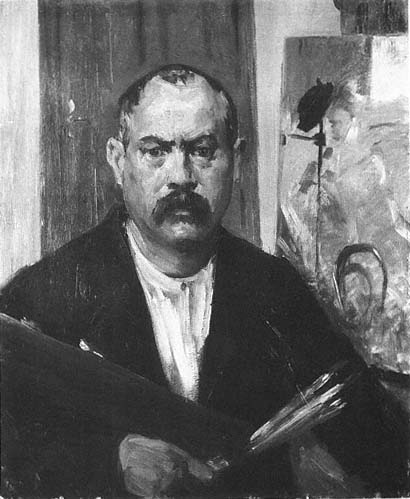
Figure 78
Lovis Corinth, Self Portrait without Collar , 1900. Oil on canvas,
73 × 60 cm, B.-C. 198. Berlin Museum, Berlin.
Photo: Hans-Joachim Bartsch.
speak of a resolute commitment to work. By comparison, the preceding Self-Portrait with Skeleton (see Plate 9) takes on a pessimistic tone that gives added meaning to the vanitas symbol of the studio prop. In the self-portrait of 1900 Corinth confronts his image together with his own "living" art in the form of a painting that bears the reassuring title Morning .
Late in December Corinth began another major figure composition, Perseus and Andromeda (B.-C. 208), with the clear intention of repeating, possibly even improving upon, the success of the Salome . The large scale of the painting—its original dimensions both more than six feet—brought with it repeated frustrations until Corinth finally cut the canvas down to its present, though still substantial, size.[112] Little is known about the reception of the painting at the Berlin Secession exhibition in May 1901. Corinth himself seems to have been pleased only with the figure of the heroine, a naturalistic depiction of the female nude, seen in the uncompromising light of the studio. While he labored on Perseus and Andromeda , he also painted several portraits, one of them—most likely the full-length portrait of Frau Liese Simon (B.-C. 197)—a commission obtained on the recommendation of Bianca Israel that netted him 3,500 marks.[113]
Having thought for some time of taking up permanent residence in Berlin, Corinth needed no further encouragement to make up his mind. At the end of March he left for Munich to wind up his affairs there and to arrange for the removal of his belongings to Berlin. In August and September he spent several weeks at Tutzing on the Starnberger See. Max Halbe was there as well, and the two were frequently joined by Frank Wedekind and Eduard von Keyserling.
At Tutzing that summer, on the terrace of Halbe's summer home, Corinth painted Keyserling's portrait (see Plate 13).[114] Eduard von Keyserling (1855–1918) had settled in Munich in 1895 to embark on a literary career. Born and raised on his ancestral estates in western Latvia, he came from a family whose forebears in the fifteenth century had been vassals of the Teutonic Knights. The practice of frequent intermarriage among blood relatives had produced in him a hybrid of intellectual acumen and physical frailty. In 1893 he experienced the first symptoms of an incurable spinal disease, and from 1908 on blindness led him to withdraw gradually from society. World War I cut him off from his Latvian sources of income, and he died in self-imposed seclusion in Munich in 1918. Keyserling's writings grew out of his life experience and his memories. His short stories and novels about the Latvian nobility are pervaded by wistful melancholy at the passing of a cherished way of life. In the
sublimated culture he so sympathetically describes, an almost ritual adherence to conventions is paired with resignation, and even dying out becomes a noble act.
Keyserling was forty-five or forty-six at the time the portrait was painted and had not yet developed his characteristic style as a writer. It is impossible to say whether Corinth knew of the illness that had begun to undermine Keyserling's health. But even if he did, his almost clinical probing of the man's character and physical constitution could not be any less astonishing. Keyserling, shown in three-quarter length and off-center, sits quietly before a simple ground that is divided horizontally about halfway up the canvas into a darker and a lighter bluish gray field animated by vigorous brushstrokes but otherwise devoid of environmental allusions. He holds his hat on his knee as if he had stopped by for only a brief visit. The immediate impression is one of calm and passivity, so unlike the assertive presence that usually marks Corinth's portraits of his male friends. Yet on closer analysis Keyserling's personality expresses itself: in the well-groomed hands, which even in repose betray a nervous sensibility; and in the face, which testifies—despite the quiet demeanor—to a rich emotional life. Indeed, the face carries the full import of the portrait, especially in conjunction with the body, whose frailty is accentuated by the loose-fitting jacket and shirt. Although Corinth limited his palette, color nonetheless plays an important part in the pictorial structure. The white tones of the shirt and vest provide an axis that links the face and the hands, and this axis is reinforced by touches of blue. The same blue is also found in the background but appears in its purest concentration in the stone of Keyserling's ring, in his necktie, and in his large eyes. It would be difficult to find among Corinth's earlier portraits an example of form serving expression more eloquently. With this painting he was on the threshold of a new beginning as a portraitist.
Corinth was aware that with his move from Munich to Berlin a major chapter in his development was coming to an end. In Munich his eyes had first been opened to a wider horizon, and his return to the city in 1891 was prompted in part by memories of his earlier and more innocent student years. Berlin now welcomed him as a mature master. The self-portrait of June 1901 reflects his recognition of this challenge (Fig. 79). Corinth dressed for the occasion with great care, adding for good measure an imposing broad-brimmed hat, as if to reinforce his new professional stature. Gazing pensively into the mirror, he contemplates rather than observes his image. Great calm emanates from the face, the only part of the painting that has been carefully modeled. Even the
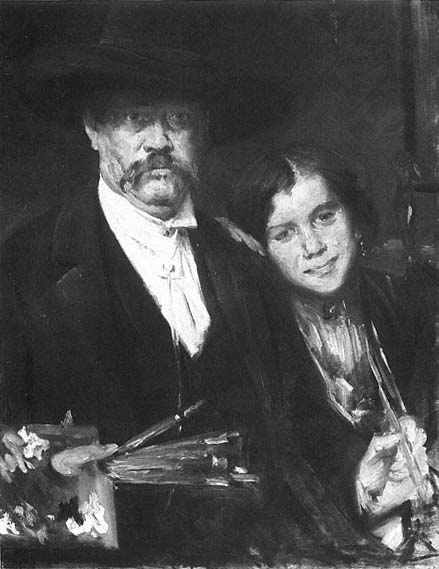
Figure 79
Lovis Corinth, Self-Portrait with Model , 1901. Oil on canvas,
88 × 68 cm, B.-C. 216. Kunstmuseum Winterthur.
Photo: Schweizerisches Institut für Kunstwissenschaft.
physiognomic details of the young woman at his side are subordinated to the vibrating surface of the canvas. Like the brushes and palette he holds, she is little more than an attribute, another tool in the service of the painter. Corinth acknowledged the special nature of the picture by inscribing the canvas in the upper right corner with the date of his birth.
As of October 3, 1901, Corinth was officially registered as living in Berlin. Leistikow, who had just acquired larger quarters for himself and his growing family, offered Corinth his old studio at Klopstockstrasse 52.[115] Stauffer-Bern had first occupied the studio in the 1880s; it was to remain Corinth's home for the rest of his life.